All Cash Parts 10% OFF
All Cash Parts 10% OFF

8345R TRACTOR
Tractor
- 345 Engine hp
- John Deere PowerTech™ 9.0L PSS
- Choice of 16-speed PowerShift, e23™ PowerShift, or Infinitely Variable Transmission (IVT™)
- MFWD, or Independent Link Suspension (ILS™)
View Product Brochure
Features
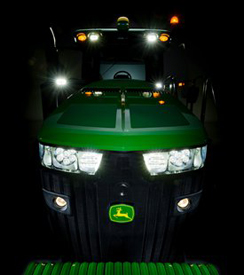 Premium lights
Premium lights
The 7R, 8R, and 8RT Series Tractors feature two lighting package options:
- Standard
- Premium
The cab lighting pattern provides 330 degrees of coverage while the hood lighting provides the remaining 30 degrees for completely programmable 360-degree, stadium-style lighting. This ensures there are no dead zones or lighting adjustments needed. The lighting configurations are available to match various applications and ensure maximum around-the-clock productivity.
Bulb housings are large, allowing for optimum total lumens and available light. The standard lighting packages use 65-W halogen bulbs, whereas the premium lighting package uses light-emitting diode (LED) lights. In the premium lighting package, these tractors take advantage of the high-performing and efficient LED technology.
The low- and high-beam driving/work lights are adjustable. Please refer to the electrical section in the operator’s manual for complete details on adjusting lights.
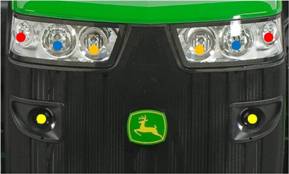 7R/8R/8RT lighting
7R/8R/8RT lighting
Yellow circles
- All lighting packages: 65-W halogen: road low beam
Red circles
- Standard: 65-W halogen
- Premium: LED
Blue circles
- Standard: 65-W halogen; field and road high beams
- Premium: LED
Orange circles
- Standard: blank
- Premium: LED
|
Standard lighting
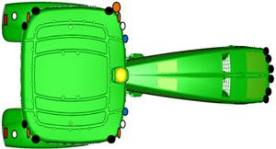 Standard lighting (8R)
Standard lighting (8R) Standard lighting (7R)
Standard lighting (7R)Six front grill-mounted lights:
- Two 65-W low-beam driving/work lights (mid grill screen)
- Two 65-W high-beam driving/work lights (top of grill screen, hood mounted)
- Two front corner-facing halogen work lights (top of grill screen, hood mounted)
10 cab roof-mounted lights:
- Two rear-facing 65-W floodlights
- Four side-facing 65-W floodlights
- Four corner-facing amber lights
Other lights:
- Two rear fender-mounted floodlights
- Two rear turn signal and brake/tail lights (fender mounted)
- Two folding-extremity lights
Plus these lights:
- Two adjustable front roof 65-W halogen floodlights
- Two front belt-line floodlights
- Rotary beacon light
Premium lighting
Eight front grill-mounted lights:
- Two 65-W low-beam halogen driving/work lights (mid grill screen)
- Two LED high-beam driving/work lights (top of grill screen, hood mounted)
- Two front corner-facing LED work lights (top of grill screen, hood mounted)
- Two front-facing LED working lights (top of grill screen, hood mounted, inner position on the sides)
12 cab roof-mounted lights:
- Four side-facing LED lights
- Four corner-facing amber lights
- Two rear-facing LED lights
- Two adjustable front roof LED lights
Other lights:
- Two rear fender-mounted LED lights
- Two rear turn signal and brake lights (fender mounted)
- Two folding-extremity lights
- Two front belt-line LED floodlights
- Rotary beacon light
The premium lighting package replaces all previous halogen and HID lights with LED lights. The only lights that are not LED are the low-beam driving lights, they remain halogen. This allows each LED light to work at a lower temperature and no one light works harder than any other. The uniformity in LED coverage allows only one type of light output surrounding the tractor.
The lighting pattern in the premium package provides industry-leading performance in nighttime visibility. LED bulbs provide maximum brightness and a true color output for excellent field definition that is easy on the operator's eyes.
The LED lights provide 40 percent greater coverage width and 10 percent more light coverage in the rear. LED lighting packages use 45 percent less amps than standard halogen lights and have an increased life expectancy over HID lights which leads to lower costs of ownership over the life of the tractor.
NOTE: Lighting packages may vary depending on region.
Selecting a lighting mode/programmable lighting
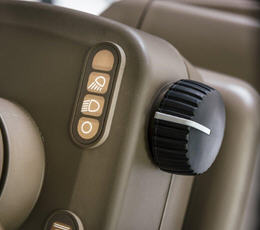 Lighting mode selector
Lighting mode selector 
Operators can quickly select a lighting mode on the steering console:
- Lights, off position
- Road lights
- Field lights
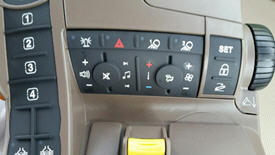 The CommandCenter™ display
The CommandCenter™ displayThe CommandCenter display allows operators to customize light settings. Operators can select only the lights they need or want for a given application and store these settings. The operator-programmed configurations can then be turned on or off with the push of a button on the CommandARM™ controls.
- Programmable field lights 1
- Programmable field lights 2
- Beacon light
- Emergency flashers
NOTE: Road/loader lights are also referred to as high-mounted driving lights for use in front hitch applications that obscure the headlights. See the Attachments section.
The battery power saver feature is also standard. When the engine is off and the outside lights have been left on, this feature is designed to avoid battery run down.
After the lights have been left on for 30 minutes and the key is in the off position, the lights cycle or blink on and off five times as an alert. The lights continue to illuminate for one more minute and then automatically shut off to protect the battery.
Field-installed options
Field-installed options are also available. To find this information, use the Build Your own Configurator application for US/Canada or Build & Price in John Deere Sales Centre for Australia/NZ.
Programmable exit lighting
Another feature is programmable exit lighting. Exit lighting allows the lights outside the cab to stay on for up to 300 seconds. They can be programmed in increments from 0 to 300 seconds.
Refer to the operator’s manual for complete instructions on programming field, driving, and exit lighting.
| Option code | Description |
| 7201 | Standard lighting |
| 7206 | Premium lighting |
ACS overview
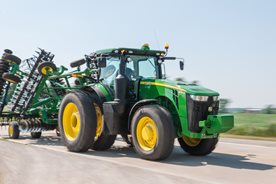 8R in transport
8R in transport
With ACS, John Deere has designed one of the most robust and full-encompassing steering system in the industry. Whether in the field or on the road, ACS reduces steering effort, which can result in reduced operator fatigue and can improve operator comfort.
There are four key features of the ACS system:
Dynamic road wheel offset:
- A gyroscope senses tractor yaw and can automatically make small steering adjustments to provide unprecedented line-holding abilities. Drive down a bumpy road and experience how ACS makes it easier to keep the tractor straight, even over rough terrain. ACS delivers the ultimate in comfort.
- ACS works to prevent over-steering when a sudden obstacle causes the operator to make a quick steering reaction.
Variable ratio steering:
- Approximately 3.5 turns lock-to-lock at in-field speeds for quick headland turns.
- Approximately 5 turns lock-to-lock at transport speeds.
Elimination of steering slop and hand wheel drift:
- Steering wheel drift and slop are eliminated with the ACS electronic control system.
Variable effort steering:
- Steering wheel resistance automatically changes with ground speed to deliver light steering effort at slower speeds for less effort during headland turns, and higher steering wheel torque at transport speeds for better comfort.
A fail operational system
The ACS system is fail operational, which means steering is still functional in the event of any single-point failure. John Deere has gone to great lengths to help ensure the operator has the ability to steer the tractor if something goes wrong in the steering system.
For example, if the primary controller fails, a second controller takes over. If power from the alternator fails, the battery resumes control. If the engine quits running and is unable to supply hydraulic oil to the system, an electric-driven backup pump is used to supply the oil. There is a backup for ACS components.
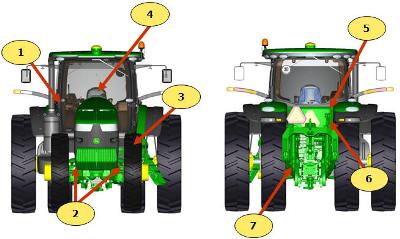 ACS components
ACS components
The ACS system consists of several key components:
- Gyroscope: this is used to measure the yaw rate (turn rate) of the tractor during transport speeds.
- Road-wheel angle sensors: these sensors simply measure the steer angle of the tractor.
- Power supply module: this module distributes the power of the battery and alternator throughout the ACS system.
- Hand-wheel angle sensors and tactile feedback unit: this includes the steering wheel position sensors and a brake which can increase or decrease resistance dependent on speed. Lighter feedback is desired during normal field use, and slightly heavier feedback is desired during transport and while the tractor is cornering at high speeds.
- Controllers: two controllers are located in the back of the tractor and are the brains of the system.
- Control valves: also known as steering valves, control valves are used to steer the tractor.
- Electric-drive backup pump: this pump supplies oil to the steering system, brakes, and park (for towing) brake if there is no longer a sufficient oil supply to the steering and brakes.
Value of ACS
- Improves line holding when driving at transport speeds
- Fewer turns lock-to-lock: 3.5 turns lock-to-lock in the field for quicker headland turns and 5 turns lock-to-lock at transport speeds
- Eliminates hand wheel backlash and drift
- Reduces steering effort results in reduced operator fatigue
- Smaller hand-wheel diameter for improved operator comfort and visibility
- Maintains operator feel and touch-points of traditional steering column system
- Fully integrates with AutoTrac™ guidance assisted steering stems
- Compatible with suspended and non-suspended front axles
- Compatible with wide and narrow section width tires
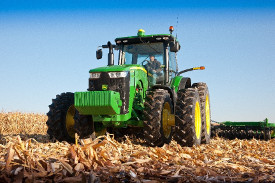 8R Series Tractor equipped with ILS
8R Series Tractor equipped with ILS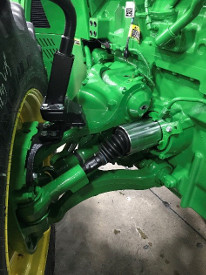 Close-up view of ILS design
Close-up view of ILS designThe John Deere ILS utilizes industry-leading technology to supply unsurpassed gains to end-user productivity. This innovative design incorporates proven suspension design with mechanical front-wheel drive (MFWD) axle components that use state-of-the-art technology specifically for heavy equipment usage.
The ILS front axle is available on all 8R Series Tractor models.
42-km/h (26-mph) and 50-km/h (31-mph) front axles
Feature | ILS |
Hydraulic differential lock | Yes |
Limited slip | No |
Suspension | Yes |
Brakes | Yes (optional on 42 km/h [26 mph]) |
Tire ratio/steps allowed | 5 or 6 |
Duals | Yes |
Tread spacing singles* | 1574 mm - 2184 mm |
Tread spacing singles | 1524 mm - 2235 mm |
Singles with duals | 1524 mm - 2235 mm |
Duals | 2946 mm - 3658 mm |
Top speed | 42 km/h (26 mph) or 50 km/h (31mph) depending on model |
Front power take-off (PTO) | Optional |
* Based on wheel equipment shipped to some geographic regions.
The ILS system gets more power to the ground because the front tires maintain ground contact pressure. This improves field and transport ride plus increases ballasting flexibility and drastically decreases the tendency to power hop.
 ILS cutaway
ILS cutawayThe ILS axle maintains minimum oil levels in the front differentials to assist in providing overall tractor operating efficiency.
John Deere ILS has three systems:
- A mechanical system
- A hydraulic system
- An electrical system
Mechanical system
The mechanical system is further broken down into the mechanical drive system and mechanical suspension system.
The mechanical drive system includes:
- A three-position switch is included on a MFWD clutch.
- The MFWD clutch has six clutch discs and separator plates that can transfer as much as 40 percent of the tractor power through to the front ILS axle.
- The front differential transfers power from the engine to the individual right and left driveshaft through a ring and pinion.
- A hydraulically engaged front differential lock containing eight clutch discs and eight separator plates works in conjunction with the rear differential lock to assist the tractor in tough, wet conditions with increased power transfer to all wheels.
- A right and left constant-velocity telescoping driveline provides smooth power transfer to the outboard hubs.
- On 8245R, 8270R, 8295R, and 8320R Tractors, the ILS driveshaft speed is 6:1. On 8345R, 8370R, and 8400R Tractors, the ILS driveshaft ratio is 8:1. By using an 8:1 ratio on higher horsepower tractors, power can get to the wheels while minimizing the torque the U-joint experiences.
The mechanical suspension system consists of large cast, upper- and lower-control arms with cast steering knuckles for durability and reliability.
- There is a high steering capacity, even with dual wheels – 25 percent increase over model year 2013
- High torque in all steering positions provides maximum transfer of power to the wheels under all conditions
- Fully independent suspension maintains optimum ground contact at all times
Hydraulic system
The hydraulic system consists of suspension cylinders, a control valve manifold, a front differential lock, and hydraulic accumulators.
- There is a high steering capacity through large steering cylinders.
- Responsive link arms maintain contact with the ground surface, giving maximum tractive performance under any condition.
- Accumulators dampen energy from bumps to produce a smooth ride for maximum operator comfort.
Electrical system
The electrical system contains position sensors, solenoids for the control valves, and a master controller for complete automatic control of the ILS system.
How does it work?
The mechanical, hydraulic, and electrical systems work together to maintain a level and vertically-centered position of the front differential case in relation to the outboard hubs and planetaries, independent of tractor weight or dynamic loading. The system's ability to maintain a vertically centered position provides full suspension travel of 25.4 cm (10 in.). This translates to consistent soil contact for improved power to the ground as well as dampens the energy from bumps that cause a rough ride.
The tractor utilizes electronic and computer controls that monitor tractor functions and axle position. Based on those inputs, the electrical system automatically triggers hydraulic functions to raise, lower, or remain static.
The John Deere ILS uses a short/long A-arm design, which means the upper control arms are shorter than the lower control arms. During wheel movement, the upper control arm moves in a smaller arc than the lower control arm, and the difference in the two arcs creates a change in camber. The change in camber helps keep the inside and outside of the front tires perpendicular to the drive surface, a very important feature when optional front dual wheels are installed. This design provides anti-dive characteristics to naturally reduce the adverse effects of braking and acceleration.
The John Deere ILS front axle has been specifically designed to accommodate additional options, such as front 3-point hitches and front duals. To properly handle these options, large steering cylinders and knuckles provide up to twice the steering capacity of the standard MFWD beam axles so steering performance is maintained. A simple steering stop arrangement offers infinite adjustability for fine-tuning in any row spacing.
Braking system
With higher speeds and expected heavy towed implements and carts, front brakes are optional on 42-km/h (26-mph) ILS-equipped tractors and part of base equipment on 50-km/h (31-mph) ILS-equipped tractors. The braking system is applied proportionally between the front and rear axle brakes to effectively stop the tractor. There are no operator adjustments or requirements to operate the additional braking system.
Tire compatibility
For travel speeds of 50 km/h (31 mph), B-speed-rated tires that provide high-speed capabilities are required.
With the ability to have a six-step drop from rear to front tire, the 8R equipped with an ILS axle is able to have group 49 rear tires with group 43 fronts. This allows for the benefits of group 49 tires while maintain the turning radius allowed by group 43 front tires.
NOTE: The use of group 44 tires for front duals does not allow for some row crop spacings.
Front duals
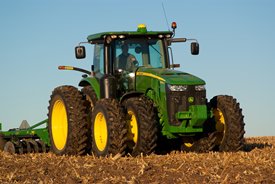 8R Series Tractor with front duals
8R Series Tractor with front duals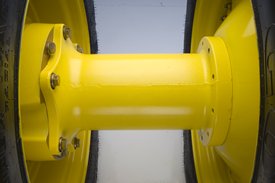 Narrow-diameter extension and hub attachment
Narrow-diameter extension and hub attachmentFront dual tires provide:
- Ultimate flotation and compaction management
- Increased load-carrying capacity
- Easy installation or removal; no need to remove the inner tire
- Bolt-on components versus studded flanges for superior flexibility for dual/no dual applications.
- Narrow hub extensions to ensure superior crop clearance for row crop applications
- A serviceability port has been added to eliminate the need to remove the front dual and hub in order to change the hub oil at the required service interval
Hitch application
In hitch applications, it is important to maintain at least 50 percent of the ballasted front-axle weight (with implement raised) for steering control. Referring to the example below, the maximum ballasted weight of the front axle is 7756 kg (17,100 lb). If the tractor has a hitch-mounted implement, when the tractor is weighed with the hitch and implement fully raised, the front weight must be at least 3878 kg (8550 lb). The front axle capacity is directly proportional to the weight that can be carried on the hitch.
The MFWD axle has a front weight carrying capacity equal to the front tire carrying capacity. For example, in row-crop applications using the popular 480/70R34 (155 load index) front tires, the highest load rating is 3878 kg (8550 lb) per tire with a total of 7756 kg (17,100 lb) at maximum tire pressure. This means (depending on tire pressure and speed) there is as much as 3878 kg (8550 lb) available for support of rear implements in transport.
Maximum load carrying capacity of the axle is determined by the load carrying capacity of the tires and whether the tractor is equipped with singles or duals.
Additional ILS features:
There is no on/off switch for ILS operation since the John Deere advanced electronic management system knows when to disengage ILS automatically. The electronic controller will activate a restricted mode of operation, when any of the following conditions are met:
- Both brake pedals are pushed
- The 3-point hitch raise/lower switch is activated
- The tractor is placed in park
- Wheel speed is less than 0.5 km/h (0.3 mph)
- Tractor is correcting for an out-of-level condition
Based on the inputs received (speed, suspension displacement, braking and operator input to hitch and/or remote cylinders), the tractor determines when the system should be active or inactive, making operation simple and efficient.
MFWD CommandARM™ controls for ILS
Shortcut keys on the CommandARM enable the operator to engage or disengage MFWD on the go, even under full load, without stopping or clutching. The switch can be placed in one of the following positions:
1. AUTO
2. On
3. Off (brake assist)
Mode 1 - AUTO
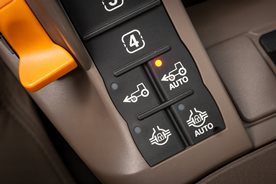 AUTO light
AUTO lightWhen this light-emitting diode (LED) light is lit, MFWD is on but automatically disengages when either of the following conditions are met:
- Either brake pedal is depressed and held to allow tighter turns
- Transporting at speeds above approximately 23.0 km/h (13.8 mph) to reduce tire wear; automatically engages when speed drops below 19.0 km/h (11.4 mph)
- When the front wheel turn angle meets an operator-defined point
As with the brake-assist position, when both brakes are depressed, the MFWD automatically engages (if not already on) to provide four-wheel braking.
 Automatic MFWD angle adjustment
Automatic MFWD angle adjustmentMode 2 - MFWD on
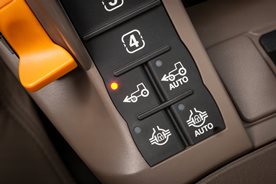 MFWD light
MFWD lightWhen this LED light is lit, MFWD engages continuously.
Mode 3 MFWD off (brake assist)
When no LED lights are lit, the MFWD is off. This is also referred to as the brake-assist position. Even though the MFWD is disengaged, when both brakes are pressed at speeds above 5 km/h (3 mph), the MFWD engages to assist braking the tractor.
Differential lock
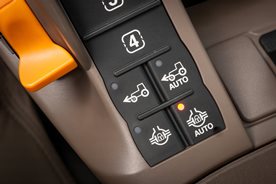 CommandARM™ controls with automatic differential lock engaged
CommandARM™ controls with automatic differential lock engaged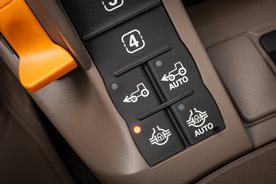 CommandARM controls with manual differential lock engaged
CommandARM controls with manual differential lock engagedThe differential lock is another feature of the ILS axle. When the rear differential lock is engaged or disengaged, the front differential lock is also engaged or disengaged. This also includes a driveline shield.
If one wheel begins to slip, the differential lock can be engaged on the go and the axles are hydraulically locked together for maximum traction. There are two ways to engage the differential lock feature.
- Manual differential lock - differential lock can be engaged manually using a switch on the floor or by manually depressing a button on the CommandARM console. When brakes are depressed, the differential lock will disengage
- Automatic differential lock - when in auto mode, differential lock is engaged when the tractor is driving forward. Differential lock will disengage when front wheel turn angle meets disengage wheel angle setting defined by the operator via the CommandCenter or when either brake pedal is depressed. Differential lock will automatically engage when brakes are released or front wheels are turned straight.
 Automatic differential lock angle adjustment
Automatic differential lock angle adjustmentAdditional equipment for use with ILS axle
- 3M front axle spacing kit:
Front axle static weight for the ILS axle shall not exceed 6759 kg (14,900 lb) using the 3M kit - H480 Front Loader
Refer to the material handling section for additional information.
All 8R and 8RT Series Tractors come standard with an 85-cc displacement integrated hydraulic pump. This pump provides 227.1 L/min (60 gpm) of hydraulic flow.
A dual-pump option, featuring 85-cc and 35-cc displacement hydraulic pumps, is available for all 8R wheel models. The dual-pump system provides a hydraulic flow of 321 L/min (85 gpm), ideal for running at lower engine speeds.
SCV flow (approximate) | ||
Engine rpm | Pump flow (85-cm3 pump) L/min (gpm) | High pump flow (85-cm3 pump + 35-cm3 optional pump) L/min (gpm) |
800 | 86 (23) | 122 (32) |
1500 | 162 (43) | 229 (61) |
1700 | 184 (49) | 260 (69) |
1900 | 206 (54) | 290 (77) |
2100 | 227 (60) | 321 (85) |
Operating the tractor at reduced engine rpm contributes to a quieter cab, reduced fuel usage, and maintains the vacuum while turning and raising the planter on end rows. At 1500 erpm with a 321 L/min (85 gpm) system there will be an available flow of 229 L/min (61 gpm). This is an improvement over an available 162 L/min (43-gpm) flow when operating with a 227 L/min (60 gpm) system at 1500 erpm.
The maximum flow through one selective control valve (SCV) with a standard coupler is 132 L/min (35 gpm). A 19.1-mm (3/4-in.) high-flow coupler allows for a maximum flow rate out of one SCV of 153 L/min (40.5 gpm).
The hydraulic system is a closed-center, power-on-demand system using a load-sensing pressure-flow compensated axial piston pump with full-flow charge and flow prioritization for steering and brakes.
The pump outlet pressure available on demand can range from 3000 kPa (435 psi) for track models and 4000 kPa (580 psi) for wheel models at low standby to 20,400 kPa (2958 psi) at high standby.
Hydraulic pump options:
- 85-cc displacement, 227-L/min (60-gpm) hydraulic pump
- NOTE: Standard on all 8R models.
- 85-cc and 35-cc dual pump option, 321-L/min (85-gpm)
- NOTE: Compatible with 2014 Final Tier 4 (FT4) and newer 8R Wheel Tractors only.
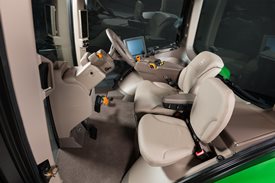 CommandView III cab
CommandView III cabThe Standard CommandView III cab offers unsurpassed visibility, operator comfort, control placement, and ride and sound quality.
Features:
- ComfortCommand™ seat with air suspension, lumbar support, swivel, fore-aft and lateral attenuation, backrest angle adjustment, adjustable left-hand armrest, and 40-degree right-hand seat swivel
- Operator presence system that warns if the operator is out of the seat while operating key functions
- Folding instructional seat
- CommandARM™ console with integrated controls
- 4100 or 4600 Generation 4 CommandCenter™ display
- Behind-the-seat storage
- Left-hand storage compartment
- Passive noise reduction system
- Service ADVISOR™ data port
- Tilt/telescoping steering wheel with position memory
- Swing-out rear window that opens 30 degrees
- Right- and left-outside mirrors (manually adjustable mirror head)
- Monitor mounts on right-hand front post and rear cab post
- Standard radio package, including AM/FM stereo and weatherband with remote controls, auxiliary input jack, four speakers, and an external antenna
- Laminated glass
- Air conditioner and heater with automatic temperature controls (ATC)
- Two 12-V convenience outlet (cigarette lighter style)
- One 12-V three-pin outlet with adapter (provides switched and unswitched power)
- One International Organization for Standardization (ISO) nine-pin connector
- Power strip with convenience plug adapter
- Hitch control lever lock and selective control lever lock
- Two-speed and intermittent front and rear wiper with washer
- Front pull-down sunshade
- Digital cornerpost display with:
- Fuel level gauge, including low fuel warning
- Temperature gauge
- Diesel exhaust fluid (DEF) gauge, including low DEF warning
- Engine rpm
- Transmission commanded gear or speed
- Vehicle system functions, such as iTEC™ system, that are operating
- Inside-mounted rearview mirror
- Beverage holders sized to accommodate various containers
- Interior left-hand dome light
ComfortCommand seat
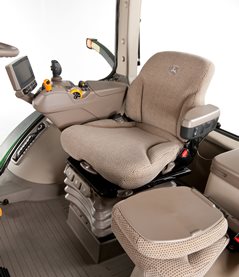 ComfortCommand seat
ComfortCommand seatComfortCommand seat improves ride quality and helps to reduce operator fatigue.
Features include:
- Armrests, lumbar support, and backrest angle are easily adjusted to match operator preference.
- Shock absorbers dampen the motion effect of the tractor for an improved ride.
- Seat height adjustments are conveniently located on the left armrest.
- Fore-aft adjustment is easy to reach located on the left front of the seat.
- Swivel adjustment, located on the front of the seat, allows the seat to be swiveled 40 degrees to the right or eight degrees to the left of the center position.
- Operator presence switch warns if the operator is out of the seat while operating key functions.
- Seat belt retractor.
- Centered cab seat provides excellent over-shoulder visibility.
- Adjustable shock absorber permits ride adjustment from soft to firm to match the operator's desired comfort level.
- Removable cushions allow for easy cleaning.
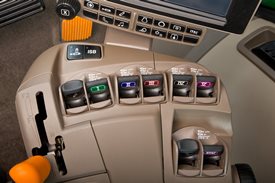 Fingertip paddle pots
Fingertip paddle pots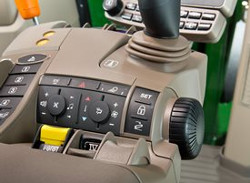 Encoder wheel
Encoder wheelCommandARM
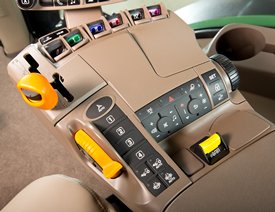 CommandARM controls
CommandARM controlsJohn Deere 7R and 8R Series Tractors feature the CommandARM with integrated Generation 4 CommandCenter display. The control layout of the CommandARM utilizes a clean and efficient design which groups controls by function and builds upon John Deere’s history of intuitive and ergonomic control placement and operation. The design of the CommandARM allows for a 40 degree right seat swivel and adjustable positioning matching the operator’s preference.
Controls located on the CommandARM include:
- Engine throttle
- FieldCruise™ system
- Minimum engine speed – CommandQuad™ transmission, 16-speed PowerShift™ transmission (PST), e23™ transmission
- Eco mode – Infinitely Variable Transmission (IVT™)
- Foot pedal lock (if equipped)
- Transmission control
- Hitch/selective control valve (SCV) controls
- Rotary encoder hitch control
- Power take-off (PTO) controls
- Mechanical front-wheel drive (MFWD) on/automatic
- Differential lock on/automatic
- iTEC sequence switches
- AutoTrac™ assisted steering system resume switch (if equipped)
- Joystick (if equipped)
- Radio
- Beacon light on/off
- Hazard lights on/off
- Field lights 1/2
- Heating, ventilation, air conditioning (HVAC) system
Transmission controls
John Deere 7R Series Tractors with CommandQuad transmissions feature a left-hand reverser. 8R Series Tractors equipped with 16-speed PST are equipped with right-hand reverser. 7R Series Tractors equipped with e23 PST offer a left- or right-hand reverser. 7R or 8R Series Tractors equipped with AutoPowr™/IVT transmissions are offered with either a left-hand or a right-hand reverser.
The transmission control lever is placed on the left side of the CommandARM closest to the operator for convenient setting and adjustment.
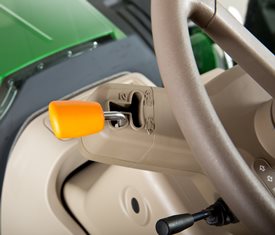 Left-hand CommandQuad/e23 reverser
Left-hand CommandQuad/e23 reverser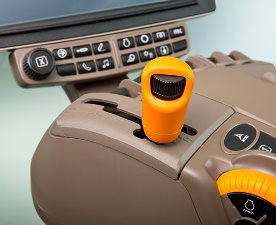 Right-hand IVT and PST reverser
Right-hand IVT and PST reverser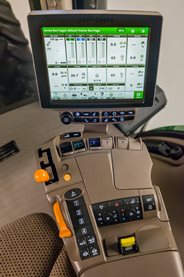 16-speed PST right-hand reverser
16-speed PST right-hand reverserHydraulic and hitch controls
Hydraulic and hitch controls utilize fingertip paddle pots for raise/lower and extend/retract functions. An optional crossgate joystick replaces fingertip paddle pots for control of SCVs and allows for programmable hydraulic functionality according to operator preference. Rear hitch position can also be controlled with the encoder wheel located on the right side of the CommandARM. The encoder wheel allows for finite positioning of the rear 3-point hitch.
Three buttons near the encoder are for hitch set, lock, and return to height. Adjustment knobs for the 3-point hitch are located under the cover for the CommandARM control's storage compartment and allow for adjustment of the rate of drop, hitch height limit, and depth control.
 Hitch controls
Hitch controls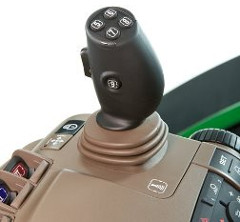 Optional crossgate joystick
Optional crossgate joystickThrottle
The throttle design incorporates buttons which control FieldCruise speed, foot pedal mode (if equipped), and transmission eco settings.
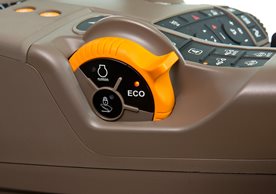 Throttle
Throttle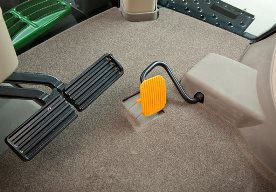 Foot throttle
Foot throttleTractor function controls
Located just to the right of the throttle is the AutoTrac activation button and four sequence controls for iTEC functions. Behind the iTEC sequence controls, there are buttons which control the activation and deactivation of MFWD and differential lock.
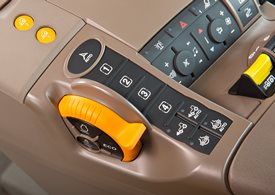 AutoTrac resume and iTEC strip
AutoTrac resume and iTEC stripControls for radio, lights, rotary beacon (if equipped), hazard flashers, and HVAC system are located to the center-right on the CommandARM, along with PTO for both front (if equipped) and rear PTO.
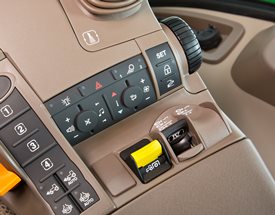 Radio, HVAC, hazard flashers, and PTO controls
Radio, HVAC, hazard flashers, and PTO controlsSeat swivel
The design of the CommandARM allows for up to 40 degrees of right-hand seat swivel.
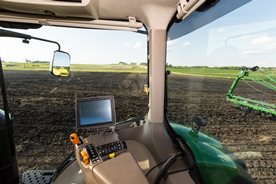 Seat swivel
Seat swivelCommandCenter
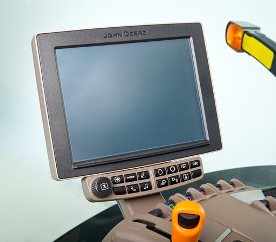 Generation 4 CommandCenter
Generation 4 CommandCenterThe Generation 4 CommandCenter features fast adjustment of tractor functions and controls and are integrated into the CommandARM to create a seamless control center. The 4100 CommandCenter features a 178-mm (7-in.) touchscreen display and is standard equipment on 7210R and 7230R models, while the 4600 CommandCenter features a 154-mm (10-in.) touchscreen and is standard equipment on 7250R – 7310R models, as well as all 8R and 8RT models.
The following functions can be adjusted using the CommandCenter display:
- Hydraulic settings
- Hitch settings
- Transmission settings
- FieldCruise
- iTEC programming functions
- Radio
- Lights
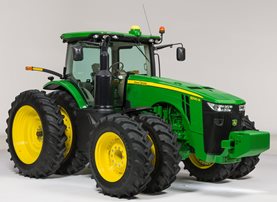

John Deere 8R Series Tractors are utilized in numerous applications that place different demands on tires. As such, multiple tire offerings are available for 8R Series Tractors to accommodate a wide range of grower needs. Tire options provide variability in terms of ground clearance, tread width, and floatation to match different operating conditions.
John Deere sources 8R Series Tractor tires from the following major brands:
- Mitas® tires
- Firestone® tires
- Goodyear® tires
- Michelin® tires
- Trelleborg® tires
Tire matching (rears and fronts)
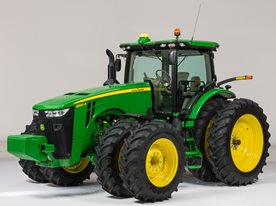 8R Series Tractor
8R Series Tractor
Front and rear tires for 8R Series Tractors are sized and combined under different group sizes based on tire rolling circumference. All front tire options for 8R Series Tractors are classified as group 42, 43, or 44, while all rear tires are classified as group 47, 48, or 49. The approximate overall diameters for each group are shown in the following table.
| Group | Overall diameter |
| 42 | 1498 mm (59 in.) |
| 43 | 1600 mm (63 in.) |
| 44 | 1676 mm (66 in.) |
| 47 | 1955 mm (77 in.) |
| 48 | 2057 mm (81 in.) |
| 49 | 2172 mm (85.5 in.) |
For tractors with mechanical front-wheel drive (MFWD) or Independent-Link Suspension (ILS™) front axles, there typically needs to be five steps (or group size difference) between the front and rear tires to maintain proper tire overspeed between axles. This means the group 42 front tire needs to be matched with group 47 rear tire, and group 43 front tire needs to be matched with group 48 rear tire.
On 1500 MFWD axles, four-step combinations between front and rear tires are also acceptable (determined at the time of ordering the tractor). This means group 44 front tire can be matched with group 48 rear tire, or group 43 front tire can be matched with group 47 rear tire. Six step combinations are possible on tractors equipped with ILS, allowing group 43 front tires to be paired with group 49 rear tires in order to maintain narrower tread functionality with row crop width tire options.
Additionally, tires have a load index rating designed to report the load carrying capability of the tire.
Group 49 rear tires
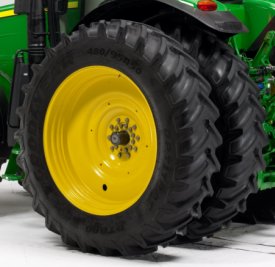

John Deere 8R Series Tractors are now approved for group 49 rear tires. Group 49 tires have a larger diameter and longer footprint, which results in greater traction in most field conditions compared to smaller group size tires of the same section width and basic design. Group 49 tires also provide a larger air volume than comparable smaller group sizes, which can help control power hop in some conditions.
NOTE:
- Front tread spacing for group 49 tires (group 44 fronts) has to be 1930 mm (76 in.) or wider based on tire size. For 762-mm (30-in.) tread spacings, tractors equipped with ILS may be equipped with group 49 rear tires and group 43 front tires.
- 710/75R42 (group 49) tires are available in singles only (see Configurator for complete offering)
- 480/95R50 (group 49) tires are available in duals only (see Configurator for complete offering)
- Operators will experience a decrease in turning radius with group 49 tires due to the larger-diameter group 44 front tires.
Row width guidelines
Multiple tire options are available for 8R Series Tractors to accommodate multiple applications or row widths. Refer to the minimum recommended row widths for tire options based on the row-width requirements in the following table.
NOTE: Not all tires listed in the chart are available on all John Deere tractors. See your local John Deere dealer for assistance in choosing the proper tires for specific tractor models.
Rear tires | Minimum recommended row width | |||||||
508 mm | 559 mm | 762 mm | 813 mm | 1016+ mm | ||||
Rear tire section width | ||||||||
RCI Group | Approximate outside diameter | 320 mm | 380 mm | 480 mm* | 520 mm* | 620 mm | 710 mm (28.0 in.) | 800 mm (31.5 in.) |
49 | 2175 mm |
|
| 480/95R50 |
|
| 710/75R42 |
|
48 | 2057 mm | 320/105R54 | 380/90R54 | 480/80R50 | 520/85R46 | 620/70R46 650/85R38 | 710/70R42 | 800/70R38 |
47 | 1956 mm | 320/90R54 | 380/90R50 | 18.4R46 480/80R46 | 20.8R42 520/85R42 | 620/70R42 650/75R38 | 710/70R38 |
|
*480 and 520 width tires will accommodate minimum tread setting of 33 in. with 85L oil takeout.
Hitch clearance and tread spacing
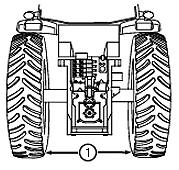 Tread spacing
Tread spacing
To prevent draft link interference, the distance (1) between the inside edges of the tires should be:
- Category 3N hitch – 1092 mm (43 in.)
- Category 3 hitch – 1168 mm (46 in.)
- Category 4N hitch – 1168 mm (46 in.)
* Tires 480 mm (19 in.) and larger may not be able to reach all tread settings. Refer to the operator’s manual for detailed tread setting limitations.
Goodyear is a trademark of Goodyear Tire and Rubber Company.
Firestone is a trademark of Bridgestone Americas Tire Operations, LLC.
Michelin is a trademark of MNA, Inc.
Mitas Tires North America is a registered subsidiary of MITAS a.s.
Trelleborg is a trademark of Trelleborg Wheel Systems, Inc.
| Front tires | Minimum recommended row width | |||||||
| 508 mm (20 in.) | 559 mm (22 in.) | 762 mm (30 in.) | 813 mm (32 in.) | 1016+ mm (40+ in.) | ||||
| Front tire section width | ||||||||
| RCI Group | Approximate outside diameter | 290 mm (11.4 in.) | 320 mm (12.6 in.) | 380 mm (15.0 in.) | 420 mm (16.5 in.) | 480 mm (18.9 in.) | 520 mm (20.5 in.) | 620 mm (24.4 in.) |
| 44 | 1676 mm (66 in.) | 540/75R34 | 620/75R30 | |||||
| 43 | 1600 mm (63 in.) | 320/80R42 | 380/80R38 | 420/85R34 | 480/70R34 | 540/65R34 | 600/70R30 | |
| 42 | 1499 mm (59 in.) | 320/85R38 | 380/85R34 | 16.9R30 420/90R30 | 480/70R30 | 540/65R30 | 600/65R28 | |
Please reference the operator’s manual for tread spacing requirements.
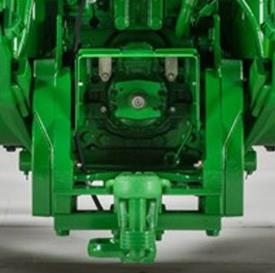 45-mm (1-3/4-in.), 1000-rpm PTO
45-mm (1-3/4-in.), 1000-rpm PTOAll 8R and 8RT Series Tractors come standard with a fully independent 45-mm (1-3/4-in.), 1000-rpm PTO. This 20-spline shaft is designed for high-power, heavy PTO loads that require full horsepower above 150 PTO hp.
The 8R Series Wheel Tractors offer additional mechanical and electrical speed-change PTO options to provide the versatility and flexibility needed to satisfy implement demands. An in-cab shiftable, eco version of the 45-mm (1-3/4-in.), 1000-rpm PTO is available, allowing full PTO rotations at decreased engine speeds.
Additionally, a 45-mm (1-3/4-in.), 1000-rpm PTO capable of 35 mm (1-3/8 in.), 540-rpm (6 spline)/1000-rpm (21 spline) can be ordered. To field convert to the 35-mm (1-3/8-in.) 540/1000-rpm PTO, a field kit is required (the required shaft is dependent on the hitch option).
NOTE: 540-rpm PTO options are not compatible with the Category 4 drawbar.
The PTO activation switch is located on the CommandARM™ controls. In addition, PTO engagement modulation is adjustable with settings located in the CommandCenter™ display. The PTO shaft can be slightly rotated or indexed to aid in PTO drive hookups. All PTO options feature internal lubrication with heavy-duty oil-cooled clutch plates. A PTO safety start system and seat-activated PTO warning is standard on all 8R and 8RT Series Tractors.
The following tables show when shaft kits are required for each PTO shaft based on the selected hitch option (drawbar, 3-point hitch, 80-mm ball/piton).
1000/540 PTO | ||||||
| PTO type | Nominal diameter, mm | Number and type of splines | PTO speed (rpm) | Drawbar | 3-point hitch | 80-mm ball/piton |
| 1 | 35 | 6 straight splines | 540 | RE272736 | RE272736 | R538037 |
| 2 | 35 | 21 involute splines | 1000 | RE272736 | RE272736 | R537791 |
| 3 | 45 | 20 involute splines | 1000 | OK from factory | OK from factory | OK from factory |
1000/1000E PTO | ||||||
| PTO type | Nominal diameter, mm | Number and type of splines | PTO speed, rpm | Drawbar | 3-point hitch | 80-mm ball/piton |
| 1 | 35 | 6 straight splines | 540 | No solution | No solution | No solution |
| 2 | 35 | 21 involute splines | 1000/1000E | R537790 | R537790 | R313423 |
| 3 | 45 | 20 involute splines | 1000/1000E | OK from factory | OK from factory | OK from factory |
General applications:
- Use the 45-mm (1-3/4-in.), 1000-rpm PTO for full-power PTO applications, such as grain carts, rotavators, and silage choppers.
- Use the 35-mm (1-3/8-in.), 1000-rpm PTO shaft on implements requiring less than 150 PTO hp, such as manure spreaders and rotary cutters.
- Use the 35-mm (1-3/8-in.), 540-rpm PTO shaft on implements requiring less than 75 PTO hp (light loads only), such as auger applications.
NOTE: Proper engine speed for the 1000-rpm PTO shaft is 2000 engine rpm. For the 540-rpm PTO shaft, proper engine speed is 1817 rpm.
Rear PTO options:
- 45-mm (1-3/4-in.), 1000-rpm (20-spline) PTO
- NOTE: Compatible with 8R and 8RT Series Tractors.
- 45-mm (1-3/4-in.), 1000-rpm (20 spline), capable of 35-mm (1-3/8-in.), 540-rpm (6-spline)/1000-rpm (21-spline) PTO
- NOTE: Compatible with 8R Wheel Tractors.
To field convert to 35-mm (1-3/8-in.), 540/1000-rpm PTO, a kit will be required.
35-mm (1-3/8-in.), 540-rpm PTO portion of this option is not compatible with the Category 4 drawbar.
- NOTE: Compatible with 8R Wheel Tractors.
- 45-mm (1-3/4-in.), 1000-rpm and 1000E economy rpm PTO, in-cab shiftable
- NOTE: Compatible with 8R Wheel Tractors only. Not compatible with 16-speed PowerShift™ transmission (PST).
Includes 45-mm (1-3/4-in.), 1000-rpm (20-spline) shaft. See Parts for additional bolt-on shafts.
- NOTE: Compatible with 8R Wheel Tractors only. Not compatible with 16-speed PowerShift™ transmission (PST).
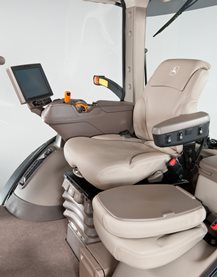 ActiveSeat and controls
ActiveSeat and controls
John Deere’s ActiveSeat utilizes electrohydraulic technology in combination with air suspension, providing the operator with enhanced ride quality over standard air-suspension seats.
Operator movements are monitored in order to reduce vertical movement. An ActiveSeat suspension can isolate the operator from up to 90 percent of vertical movements typically seen in tractor applications.
The system uses a hydraulic cylinder that is connected to a control valve assembly. Electrohydraulic valves located in the control valve assembly automatically react to inputs from two sensors, a position sensor and an accelerometer. Inputs from these two sensors control oil flow from the tractor to the hydraulic cylinder to reduce the vertical movement of the operator.
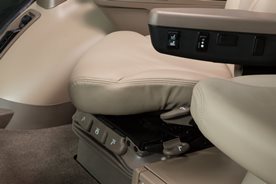 ActiveSeat left armrest
ActiveSeat left armrest
The John Deere ActiveSeat has many of the same features of the ComfortCommand™ seat with the addition of a ride firmness switch. The ride firmness switch is located on the left-hand armrest and replaces the suspension shock-dampening seat attenuation lever on the front right-hand side of the ComfortCommand seat controls.
The ride firmness switch has three positions: plus, minus, and mid position. The three positions provide three different levels of seat performance:
- The plus position provides the greatest degree of ride firmness. This position allows more of the tractor's inputs to be felt by the operator (slightly rougher ride).
- The minus position provides the least degree of ride firmness, allowing minimal tractor inputs to reach the operator, resulting in maximum seat performance.
- The mid position allows a balance between the plus (+) and minus (-) settings.
The ActiveSeat is also available as a heated leather seat for increased comfort and easier cleaning. For tractor applications where operating speed is not limited by the implement, the ActiveSeat can allow for faster field speeds and increased overall comfort and productivity.
NOTE: The John Deere ActiveSeat is not available on track tractors.
| Option code | Description |
| 2061 | Premium CommandView III Cab with Active Seat |
The Generation 4 CommandCenter was designed to provide a consistent user experience by providing full-screen viewing of more run page modules, shortcut keys, and precision agriculture capabilities.
Expect easier set-up, along with increased operator confidence, thanks to a simple, customizable interface. The improved design of the Generation 4 CommandCenter also aids in an optimal operating experience and maximizes uptime.
In order to increase your efficiency, take advantage of the following features offered by the Generation 4 CommandCenter:
Layout manager
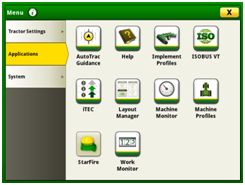 Layout manager selection page
Layout manager selection page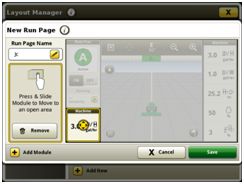 Layout manager module build
Layout manager module build- Easily create page views that meet your needs and that are also equipped with default run pages.
- Users and access allow the owner or manager to lock out certain functions to prevent operators from accessing or changing settings with a defined four-digit code.
- Gather on-screen help by selecting the help icon on the shortcut bar on the bottom of every page.
Machine monitor
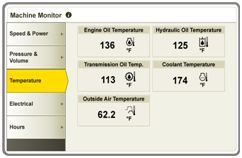 Machine monitor page
Machine monitor page- The Machine Monitor application provides you instantaneous readings about the status or condition of your machine.
- This application shows parameters such as engine speed, coolant temperature, and ground speed.
Work monitor
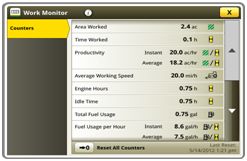 Work monitor page
Work monitor page- The Work Monitor application displays performance information about the task being performed by the machine.
- You are shown averages, totals, and productivity of the machine, such as area worked, average working speed, and fuel usage.
- Work setup places the settings needed to properly setup features such as AutoTrac, Documentation, and Section Control in a single location. Settings include:
- Client, farm, and field
- Crop type
- Machine and implement dimensions
- Variety/hybrid and planting/seeding rates
- Variable rate prescriptions
- Product and application rates
- Application rates through the implement screens
Video capability
- Machines equipped with a 4200 CommandCenter are equipped with one video input, and the 4600 CommandCenter has four video inputs.
- You have the ability to set a variety of triggers. With each trigger, the image will then appear on the display.
Flags
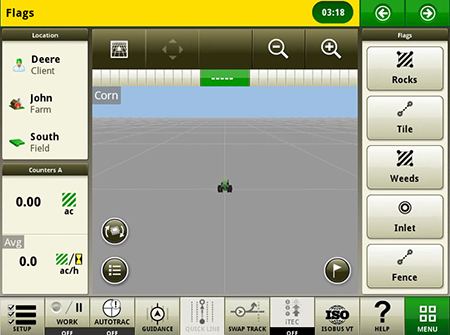 Create flags to mark items in the field
Create flags to mark items in the field- Mark areas in the field that need special attention such as rocks, tile lines, or weed pressure.
- Flags previously recorded on the Gen 4 or GreenStar™ 3 2630 Display can be transferred between monitors.
- Flags previously recorded on the Gen 4 or GreenStar™ 3 2630 Display can be transferred between monitors.
Field boundaries
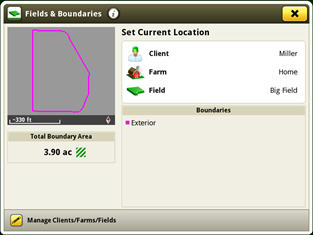 Boundary creation from coverage
Boundary creation from coverage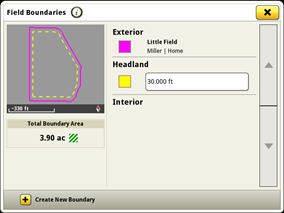 Headland creation
Headland creation- Manually drive field boundaries with the Generation 4 CommandCenter or import existing boundary information from the GreenStar 3 2630 Display or John Deere Operations Center. Gen 4 documentation data can be used to create boundaries from coverage within the John Deere Operations Center.
Dual-display mode
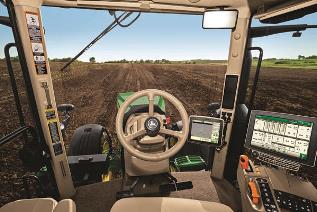 Dual display
Dual display- Generation 4 CommandCenter may be configured to run with the following John Deere displays connected at the cornerpost of a John Deere tractor:
- GreenStar 2 1800 Display
- GreenStar 2 2600 Display
- GreenStar 3 2630 Display
- 4640 Universal Display
- 4240 Universal Display
NOTE: Vehicle applications will always be located on the Gen 4 CommandCenter.
Automatic base station switching
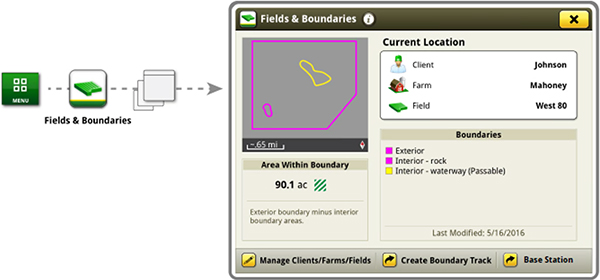 Setup base stations in Fields and Boundaries applications
Setup base stations in Fields and Boundaries applications- Customers using John Deere RTK Radio 450 or 900 can link a base station to a desired client,/ farm,/ or field. This allows automatic switching to the associated base station when changing fields. The ability to import base station assignments into Operations Center and send back to machines will be available at a later date.
Video looping supported with Gen 4 4600 CommandCenter Display and 4640 Universal Display
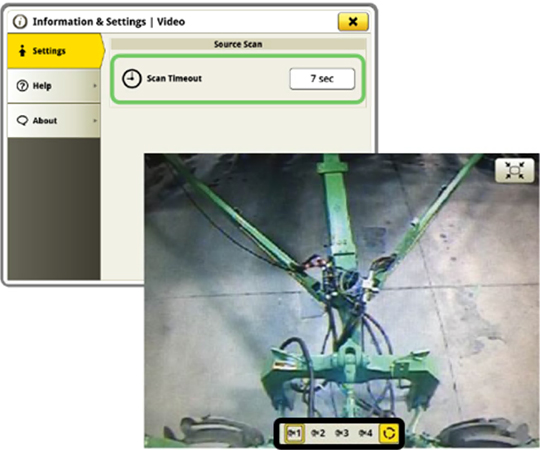 Scan through videos with video looping
Scan through videos with video looping- This feature enables users to scan or loop through all of the available video feeds for a specified duration. The default scan time is set to 7 seconds per image. The scan time is customizable per image allowing for consistent visibility to all video feeds.
Specifications
Compare the specifications of up to 4 models
| Key Specs | 8345r-tractor Current Model |
|---|---|
| Engine description | John Deere PowerTech™ PSS 9.0 L (B20 diesel compatible) |
| Engine displacement | 9 L 549 cu in. |
| Rated engine power | 97/68EC: 254 kW 345 hp |
| Rated PTO power (hp SAE) | 216 kW 291 hp |
| Transmission type | Standard: e23 Powershit with Efficiency Manager™ 40K, 40 km/h 26 mph Optional: e23 Powershift with Efficiency Manager™ 50K, 50 km/h 31 mph John Deere AutoPowr™ IVT™ 40K, 26 mph (0.05-42 km/h) John Deere AutoPowr™ IVT™ 50K, 31 mph (0.05-50 km/h) |
| Hydraulic pump rated output | Standard: 85-cc pump: 227.1 L/min 60 gpm Optional: 85-cc plus 35-cc dual pump: 321 L/min 85 gpm |
| Rear hitch category (SAE designation) | Standard: Category 4N/3: 9,072 kg (20,000 lb) standard lift at 610 mm behind hitchpoint Optional: Category 4N/3: 6,803 kg (15,000 lb) at 610 mm behind hitchpoint |
| Base machine weight | ILS/e23: 14,270 kg 31,459 lb |
| Maximum PTO power | |
| Maximum engine power | |
| Engine specifications | |
| Description | John Deere PowerTech™ PSS 9.0 L (B20 diesel compatible) |
| Engine type | Diesel, in-line, 6-cylinder, wet-sleeve cylinder liners with 4 valves-in-head |
| Engine family | JJDXL09.0308 |
| Rated speed | 2100 rpm |
| Aspiration | Dual series turbocharger with fixed geometry first stage, variable geometry second stage; air-to-air aftercooling and cooled exhaust gas recirculation |
| Cylinders liners | |
| Emission level | Final Tier 4 |
| After treatment type | DOC/DPF/SCR |
| Displacement | 9 L 549 cu in. |
| Engine performance | |
| Rated power | 97/68EC: 254 kW 345 hp |
| Rated PTO power (hp SAE) | 216 kW 291 hp |
| Power boost | 10 percent |
| Engine peak torque | At 1600 rpm: 1,615 Nm 1,191 lb-ft |
| PTO torque rise | 40 percent |
| Intelligent Power Management (available in transport and/or mobile PTO applications) | |
| Maximum PTO power | |
| Maximum engine power | |
| Transmission | |
| Type | Standard: e23 Powershit with Efficiency Manager™ 40K, 40 km/h 26 mph Optional: e23 Powershift with Efficiency Manager™ 50K, 50 km/h 31 mph John Deere AutoPowr™ IVT™ 40K, 26 mph (0.05-42 km/h) John Deere AutoPowr™ IVT™ 50K, 31 mph (0.05-50 km/h) |
| Reverser | |
| Clutch; wet/dry | |
| Creeper | |
| Hydraulic system | |
| Type | Closed-center, pressure/flow compensated |
| Pump rated output | Standard: 85-cc pump: 227.1 L/min 60 gpm Optional: 85-cc plus 35-cc dual pump: 321 L/min 85 gpm |
| Available flow at a single rear SCV | 0.5 in. couplers: 132 L/min 35 gpm 0.75 in coupler: 159 L/min 42 gpm |
| Available flow at front SCVs | 96 L/min 25 gpm |
| Number of rear selective control valves (SCVs) | Standard: 0.5 in. ISO couplers: 8 Optional: 0.5 in. ISO Couplers: 5 and 6 available 0.75 in. ISO couplers: 5 |
| Number of mid selective control valves (SCVs) | |
| Number of front selective control valves (SCVs) | |
| Joystick SCV control | |
| SCV control | Electronic |
| Rear hitch | |
| Hitch draft control load sense type | |
| Remote control valves available | |
| Hitch category (SAE designation) | Standard: Category 4N/3: 9,072 kg (20,000 lb) standard lift at 610 mm behind hitchpoint Optional: Category 4N/3: 6,803 kg (15,000 lb) at 610 mm behind hitchpoint |
| Maximum lift capacity behind lift points | Standard: 12,124 kg (26,729 lb) at 610 mm behind hitchpoint |
| Sensing type | Electrohydraulic |
| Rear axle differential lock | |
| Lift capacity at standard frame | |
| Drawbar | |
| Drawbar category | Standard: Category 4 Optional: Category 4 with heavy duty support |
| Maximum vertical load | 4,990 kg 11,000 lb |
| Rear power take-off (PTO) | |
| Type | Independent Standard: 44 mm (1.75 in.) 20-spline, 1,000 rpm Optional: 44 mm (1.75 in.), 20-spline, 1,000 rpm capable of 35 mm (1.375 in.) 540/1000 rpm 44 mm (1.75 in.) 20-spline, 1,000 rpm/1,000E rpm |
| Engine rpm (at rated PTO speeds) | IVT: 1,000 PTO rpm at 2,000 engine rpm 1,000 ECO PTO at 1594 engine rpm 540 PTO rpm at 1,814 engine rpm e23 PST: 1,000 PTO rpm at 1,995 engine rpm 1,000 ECO PTO at 1,590 engine rpm 540 PTO rpm at 1,810 engine rpm |
| PTO actuation | |
| Ground speed PTO option availability | |
| Multispeed PTO option availability | |
| Front hitch | |
| Category | Category 3N |
| Electric power | |
| Standard lift capacity | Category 3N ground engaging front hitch: 5,200 kg (11,464 lb) lift capacity |
| Front power take-off (PTO) | 44 mm (1.75 in) 20 spline, 1,000 rpm 35 mm (1.375 in) 21 spline, 1,000 rpm 35 mm (1.375 in) 6 spline, 1,000 rpm (available dependent on location) |
| PTO speed | 1,000 PTO rpm at 2000 engine rpm |
| Rear axle | |
| Type | Standard: Rack-and-pinion, double flat, or flange axles Optional: Long, dual taper hub: Diameter: 120 x 3010 mm 4.72 x 118.5 in. Short, double flat axle with single taper hub: Diameter: 120 x 2550 mm 4.72 x 100.4 in. |
| Final drive type | Inboard planetary three pinion |
| Differential controls | |
| Axle type | |
| Brakes, type and control | |
| Rear differential lock | Full-locking electrohydraulic |
| Load rating | |
| Front axle | |
| Type | Standard: ILS Optional: 1500 Series MFWD |
| Front axle differential lock | 1500 Series MFWD: Full-locking electrohydraulic ILS: Full-locking electrohydraulic |
| Load rating | |
| Tires | |
| Front | |
| Rear | |
| Wheel tread range | 1500 Series MFWD: 1,524-3,657 mm 60-144 in. ILS: 1,524-3,657 mm |
| Turning radius with brakes | |
| Turning radius without brakes | ILS with 380/85R34 group 42 tires at 60 in. spacing, 5.42 m 17.8 ft |
| Steering | |
| Type | Standard: Hydraulic power-steering with electric pump back-up Optional: ActiveCommand™ Steering (ACS) with electric pump back-up |
| Electrical system | |
| Alternator size | Standard: 200 amp |
| Battery options | 12 V |
| Total cold cranking amps | 1,850 CCA |
| Type of bulb in beacon (Halogen, Zenon, LED) | |
| Type of bulb in headlight (Halogen, Zenon, LED) | |
| Working lights | |
| dB(A) rating for backup alarm | |
| Operator station | |
| Rollover protective structure, OOS | |
| Seat | Standard: ComfortCommand™ Optional: ActiveSeat™ |
| Cab suspension | Optional |
| Instructional seat | Standard |
| Display | Standard: 4100 Generation 4 CommandCenter™ with 7 in. display Optional: 4600 Generation 4 CommandCenter™ with 10 in. display |
| Radio | Standard: AM/FM stereo with weatherband, remote controls, auxiliary input jack, four speakers and external antenna |
| Inner cab volume | 3.597 m3 127 cu ft |
| dB(A) rating | |
| Cab glass area | 6.52 m2 70.18 sq ft |
| Front visibility | |
| Safety glass rating | |
| Dimensions | |
| Wheelbase | MFWD: 3,080 mm 121.3 in. ILS: 3,050 mm 120.1 in. |
| Overall length | 6,636 mm 261.3 in. |
| Drawbar clearance | 376 mm 14.8 in. |
| Front axle center | MFWD: 686 mm 27 in. ILS: 590 mm 23.2 in. |
| Approximate shipping weight, Open;Cab | |
| Overall height | |
| Weight | |
| Base machine weight | ILS/e23: 14,270 kg 31,459 lb |
| Maximum ballast level | SAE PTO kW: 88.6 kg SAE PTO hp: 145 lb |
| Maximum permissible weight | |
| Capacities | |
| Crankcase oil volume | 1500 MFWD: 28 L 7.4 U.S. gal. ILS: 27.5 L 7.3 U.S. gal. |
| Fuel tank | Group 47/48: 615 L 162.5 U.S. gal. Group 49: 676 L 178.6 U.S. gal. |
| Diesel exhaust fluid (DEF) tank | 23 L 6 U.S. gal. |
| Cooling system | 32.6 L 8.6 U.S. gal. |
| Transmission-hydraulic system | MFWD: 140 L 37 U.S. gal. ILS: 165 L 43.6 U.S. gal. |
| Serviceability | |
| Interval for engine oil change | 500 hours |
| Interval for hydraulic/transmission oil change | 1,500 hours |
| Interval for engine coolant change | 6,000 hours |
| Loaders | |
| Loader | H480 |
| Lift capacity at full height | 2,486 kg 5,469 lb measured at 800 mm ahead of pivot |
| Maximum lift height | 4,735 mm 186 in. |
| Precision AG | |
| Guidance | AutoTrac Ready |
| Telematic | Available with JDLink™ hardware, activations, and Ethernet Harnesses (availability dependent upon destination) |
| Remote diagnostics | Available with activated JDLink™ hardware and activations |
| Miscellaneous | |
| Country of manufacture | USA |
| Side slope rating | |
| Uphill/downhill slope rating | |
| Tracks | |
| Drive type | |
| Midrollers | |
| Track width | |
| Tread spacing |
Accessories and Attachments
Electrical
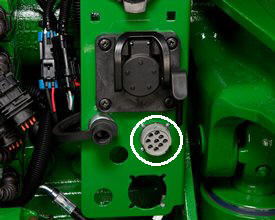 9-pin implement electrical connector
9-pin implement electrical connectorThe RE58827 9-pin electrical connector is required for TouchSetTM depth control to be used with implements with this feature. The harness provides a position input to the tractor selective control valve unit enabling the TouchSet system.
This feature allows the operator to adjust height and depth of remote lift cylinders by using the TouchSet controls in the cab.
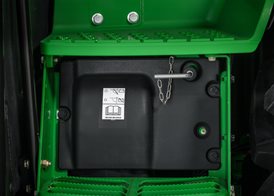 Battery disconnect installed
Battery disconnect installed
Available as either a factory- or field-installed attachment, the battery disconnect switch is used to disconnect the batteries in preparation for 20-day to 90-day storage periods. The switch cuts the power to the entire tractor to aid in maintaining battery life.
An indicator light allows for safe and proper disconnect. The light will flash until it is safe to disconnect. This allows the diesel exhaust fluid (DEF) tank and lines to purge. (Final Tier 4 has an indicator light and Interim Tier 4 has no indicator light)
Cummins is a trademark of Cummins Incorporated.
Front Implement CAN Communication Connector - RE344751
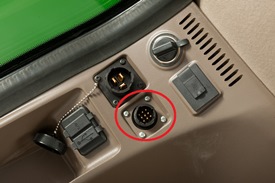 ISO 11783 location in R-Series Tractor cab
ISO 11783 location in R-Series Tractor cab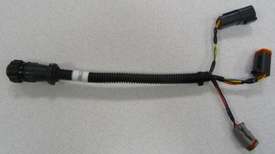 RE322780 ISO cab implement CAN bus adapter
RE322780 ISO cab implement CAN bus adapterThe ISO cab implement controller area network (CAN) bus adapter is available to connect any ISO compliant implement or device to an 8R, 8RT, 9R, 9RT, 9RX (including Scraper Special) Series Tractor. These connectors are commonly used for planter frame control boxes.
Refer to the operator's manual, sections 16 (CommandCenter™) and 25 (Operator Station), for additional information on ISO implements.
NOTE: If the harness is not in use, unplug it from the ISO 11783 location or plug the 4-pin connectors together on the harness. If neither of these are done, implement CAN communication errors will occur.
 Implement switch
Implement switch The implement switch indicates to the CommandCenter™ when the implement is raised or lowered, to provide accurate data collection when using a performance monitor.
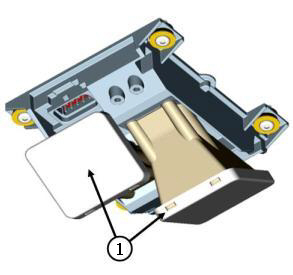 Dual-beam radar emission horns
Dual-beam radar emission horns 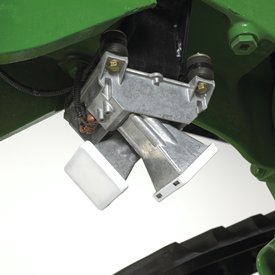 Dual-beam radar (tracks tractor shown)
Dual-beam radar (tracks tractor shown)In today’s agricultural environment, accuracy and precision are more important than ever. For something as basic as ground speed, operators need key information for precise control of various implements and the tractor. To support these needs, tractors can be ordered with a dual-beam radar unit as a factory- or field-installed option.
There are several key features that have changed from previous designs.
First, there are two horns for exit of the radio beam. This dual-beam design assures a powerful and accurate signal that will cut through interference that at times makes single-beam units inaccurate. (See 1 in the image above for beam locations.) Dual-beam output makes radar less susceptible to hard surface or tall/wavy grass interference.
Accuracy is aided by a heavy-gauge mounting bracket and rubber isolators that reduce chances that vibration can affect the radio signal.
Dual-beam radar has a fast update rate. When the tractor comes to a stop, accelerates, or varies speed, the indicated ground speed on the tractor display will closely match the actual ground speed. This is important for implements that use radar speed to control operation such as planters, seeders, fertilizer applicators, and sprayers.
In addition, the dual-beam radar does not require calibration to assure accuracy. Its self-calibrating ability is sure to save setup time by elimination of a special procedure that was required in the past.
The radar true ground speed sensor activates the following CommandCenterTM or performance monitor readouts:
- Percent slip
- Hitch slip command (if equipped)
Radar usage improves the accuracy of the following CommandCenter or performance monitor functions:
- Area covered
- Area/hour
- Distance and ground speed
Dual-beam units are compatible with controller area network (CAN) bus and International Organization for Standardization (ISO) bus electrical systems.
 Dual-beam radar emission horns
Dual-beam radar emission horns  Dual-beam radar (tracks tractor shown)
Dual-beam radar (tracks tractor shown)In today’s agricultural environment, accuracy and precision are more important than ever. For something as basic as ground speed, operators need key information for precise control of various implements and the tractor. To support these needs, tractors can be ordered with a dual-beam radar unit as a factory- or field-installed option.
There are several key features that have changed from previous designs.
First, there are two horns for exit of the radio beam. This dual-beam design assures a powerful and accurate signal that will cut through interference that at times makes single-beam units inaccurate. (See 1 in the image above for beam locations.) Dual-beam output makes radar less susceptible to hard surface or tall/wavy grass interference.
Accuracy is aided by a heavy-gauge mounting bracket and rubber isolators that reduce chances that vibration can affect the radio signal.
Dual-beam radar has a fast update rate. When the tractor comes to a stop, accelerates, or varies speed, the indicated ground speed on the tractor display will closely match the actual ground speed. This is important for implements that use radar speed to control operation such as planters, seeders, fertilizer applicators, and sprayers.
In addition, the dual-beam radar does not require calibration to assure accuracy. Its self-calibrating ability is sure to save setup time by elimination of a special procedure that was required in the past.
The radar true ground speed sensor activates the following CommandCenterTM or performance monitor readouts:
- Percent slip
- Hitch slip command (if equipped)
Radar usage improves the accuracy of the following CommandCenter or performance monitor functions:
- Area covered
- Area/hour
- Distance and ground speed
Dual-beam units are compatible with controller area network (CAN) bus and International Organization for Standardization (ISO) bus electrical systems.
Transmission Back-up Alarm, Wheel - BRE10166
Engine
Engine Block Heater (110V) - DZ102076
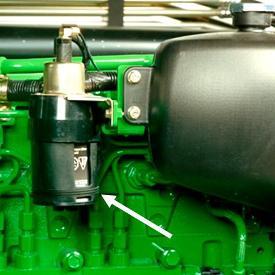 Ether valve and canister
Ether valve and canister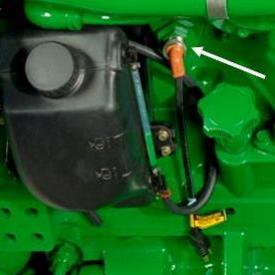 Block heater
Block heaterThe optional cold start package is recommended for tractors frequently started at or below -6°C (21.2°F).
The kit includes factory-installed activation switch and ether valve with ether canister. A 110-V, high-wattage block heater and grounded cord are also included with the factory-installed option.
 Ether valve and canister
Ether valve and canister
The engine ether kit is recommended for tractors frequently started in cold weather. This kit injects ether into the engine allowing quick combustion in below-average temperatures.
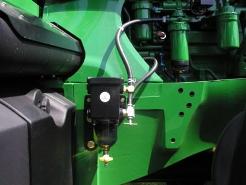 7030 Series Large-Frame Tractor shown
7030 Series Large-Frame Tractor shownThe severe-duty water separator factory-installed option or field-installed kit is available for locations where fuel quality can at times be in question. This kit will extend service intervals and help protect the tractor fuel system from damage if the fuel contains more water than the base filtering equipment can handle on a continual basis.
The 60 micron constructed of stainless-steel filter element must be backflushed whenever the bowl is half full of water. The filter can be backflushed up to five times before the filter must be removed and cleaned. Filter element must be replaced when light is no longer visible through the filter. The replacement interval will vary depending on fuel quality.
Fenders
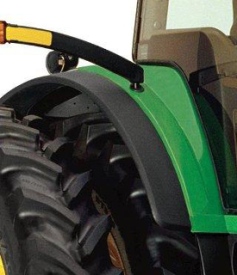 Full-coverage fenders
Full-coverage fenders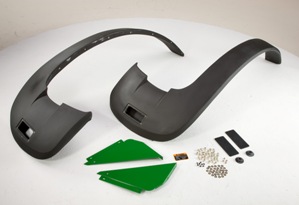 Full-coverage fenders kit for 8030 Series
Full-coverage fenders kit for 8030 SeriesRear fenders are designed to provide optimum mud control by increasing the coverage of the rear tires in all directions. Two rear fender extension options are offered to provide overall width coverage of 2.55 m (100 in.) or 2.75 m (108 in.).
Most importantly, the fender increases the coverage over the rear of the tire, decreasing the amount of mud or debris buildup on the cab's windows, selective control valve (SCV) stack, hitch, and drawbar.
Rear fenders are available as factory-installed or as a field-installed attachment.
 Full-coverage fenders
Full-coverage fenders Full-coverage fenders kit for 8030 Series
Full-coverage fenders kit for 8030 SeriesRear fenders are designed to provide optimum mud control by increasing the coverage of the rear tires in all directions. Two rear fender extension options are offered to provide overall width coverage of 2.55 m (100 in.) or 2.75 m (108 in.).
Most importantly, the fender increases the coverage over the rear of the tire, decreasing the amount of mud or debris buildup on the cab's windows, selective control valve (SCV) stack, hitch, and drawbar.
Rear fenders are available as factory-installed or as a field-installed attachment.
Fenders, Pivoting Front - 710 mm (27.9 In.) Wide for ILS - BRE10086
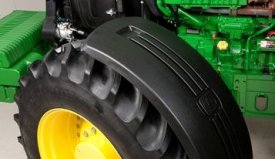 Deluxe, pivoting front fender on a 7R Series Tractor
Deluxe, pivoting front fender on a 7R Series TractorThe optional deluxe, pivoting front fenders for 7R and 8R Series Tractors help protect the operator station from mud and debris. Three full-coverage pivoting front fenders are offered:
- 480-mm (18.4-in.) width front fenders for tires that are 290 mm (12.4 in.) to 420 mm (16.9 in.) in section width
- 620-mm (24.4-in.) width front fenders for tires that are 480 mm (18.4 in.) to 600 mm (23.6 in.) in section width
- 710-mm (27.9-in.) width front fenders for tires that are 480 mm (18.4 in.) to 650 mm (25.6 in.) in section width (NOTE: Not available on model year 2018 or newer 8R Series tractors with 1500 front axles.)
The pivoting fenders feature a full range of adjustments to accommodate a variety of tread settings. A spring allows the fender bracket to bump the tractor frame and then swivel, allowing for tighter turns. All fenders are made from heavy-duty polymers for high durability and long life, and offer ultraviolet protection for fade resistance.
NOTE: Fenders are designed to cover only one front tire. Also, the deluxe, pivoting front fenders are not compatible with the H480 Loader. Stationary loader fenders are compatible with the H480 Loader and are orderable through loader Price Pages as well as tractor Price Pages. When a 7R is ordered from the factory with a loader-ready package, selecting code 8011 will equip tractor with stationary loader fenders.
 Deluxe, pivoting front fender on a 7R Series Tractor
Deluxe, pivoting front fender on a 7R Series TractorThe optional deluxe, pivoting front fenders for 7R and 8R Series Tractors help protect the operator station from mud and debris. Three full-coverage pivoting front fenders are offered:
- 480-mm (18.4-in.) width front fenders for tires that are 290 mm (12.4 in.) to 420 mm (16.9 in.) in section width
- 620-mm (24.4-in.) width front fenders for tires that are 480 mm (18.4 in.) to 600 mm (23.6 in.) in section width
- 710-mm (27.9-in.) width front fenders for tires that are 480 mm (18.4 in.) to 650 mm (25.6 in.) in section width (NOTE: Not available on model year 2018 or newer 8R Series tractors with 1500 front axles.)
The pivoting fenders feature a full range of adjustments to accommodate a variety of tread settings. A spring allows the fender bracket to bump the tractor frame and then swivel, allowing for tighter turns. All fenders are made from heavy-duty polymers for high durability and long life, and offer ultraviolet protection for fade resistance.
NOTE: Fenders are designed to cover only one front tire. Also, the deluxe, pivoting front fenders are not compatible with the H480 Loader. Stationary loader fenders are compatible with the H480 Loader and are orderable through loader Price Pages as well as tractor Price Pages. When a 7R is ordered from the factory with a loader-ready package, selecting code 8011 will equip tractor with stationary loader fenders.
 Deluxe, pivoting front fender on a 7R Series Tractor
Deluxe, pivoting front fender on a 7R Series TractorThe optional deluxe, pivoting front fenders for 7R and 8R Series Tractors help protect the operator station from mud and debris. Three full-coverage pivoting front fenders are offered:
- 480-mm (18.4-in.) width front fenders for tires that are 290 mm (12.4 in.) to 420 mm (16.9 in.) in section width
- 620-mm (24.4-in.) width front fenders for tires that are 480 mm (18.4 in.) to 600 mm (23.6 in.) in section width
- 710-mm (27.9-in.) width front fenders for tires that are 480 mm (18.4 in.) to 650 mm (25.6 in.) in section width (NOTE: Not available on model year 2018 or newer 8R Series tractors with 1500 front axles.)
The pivoting fenders feature a full range of adjustments to accommodate a variety of tread settings. A spring allows the fender bracket to bump the tractor frame and then swivel, allowing for tighter turns. All fenders are made from heavy-duty polymers for high durability and long life, and offer ultraviolet protection for fade resistance.
NOTE: Fenders are designed to cover only one front tire. Also, the deluxe, pivoting front fenders are not compatible with the H480 Loader. Stationary loader fenders are compatible with the H480 Loader and are orderable through loader Price Pages as well as tractor Price Pages. When a 7R is ordered from the factory with a loader-ready package, selecting code 8011 will equip tractor with stationary loader fenders.
 Deluxe, pivoting front fender on a 7R Series Tractor
Deluxe, pivoting front fender on a 7R Series TractorThe optional deluxe, pivoting front fenders for 7R and 8R Series Tractors help protect the operator station from mud and debris. Three full-coverage pivoting front fenders are offered:
- 480-mm (18.4-in.) width front fenders for tires that are 290 mm (12.4 in.) to 420 mm (16.9 in.) in section width
- 620-mm (24.4-in.) width front fenders for tires that are 480 mm (18.4 in.) to 600 mm (23.6 in.) in section width
- 710-mm (27.9-in.) width front fenders for tires that are 480 mm (18.4 in.) to 650 mm (25.6 in.) in section width (NOTE: Not available on model year 2018 or newer 8R Series tractors with 1500 front axles.)
The pivoting fenders feature a full range of adjustments to accommodate a variety of tread settings. A spring allows the fender bracket to bump the tractor frame and then swivel, allowing for tighter turns. All fenders are made from heavy-duty polymers for high durability and long life, and offer ultraviolet protection for fade resistance.
NOTE: Fenders are designed to cover only one front tire. Also, the deluxe, pivoting front fenders are not compatible with the H480 Loader. Stationary loader fenders are compatible with the H480 Loader and are orderable through loader Price Pages as well as tractor Price Pages. When a 7R is ordered from the factory with a loader-ready package, selecting code 8011 will equip tractor with stationary loader fenders.
Fenders, Pivoting Front - 710 mm (27.9 In.) Wide for 1500 Series MFWD - BRE10085
GreenStar Miscellaneous Hardware
GreenStar and Gen 4 Harnesses
Hitch and Drawbar
BRE10139
Center Link Bracket - R177682
All 8R and 8RT Series Tractors offer a Category 4 drawbar, with or without heavy-duty supports. The heavy- duty support option provides a maximum vertical load-carrying capacity of up to 4990 kg (11,000 lb). A Category 3 drawbar is also available for wheel models. The Category 4 drawbars include a 50-mm (2-in.) pin, and the Category 3 drawbar includes a 38-mm (1.5-in.) pin.
All drawbar options provide an easy-to-use linkage that allows the drawbar pin to drop into the field position when hooking up to an implement. This linkage is activated when it is tapped by the implement drawbar.
Drawbar description | Model availability (A=Available) | |
8R | 8RT | |
| Category 3 adjustable swinging drawbar with 38-mm (1.5-in.) pin | A | -- |
| Category 4 adjustable swinging drawbar with 50-mm (2-in.) pin | A | A |
| Category 4 adjustable swinging drawbar with 50-mm (2-in.) pin with heavy-duty support | A | A |
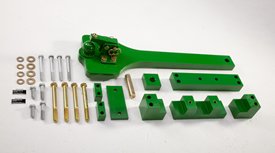 Ball-type drawbar kit for 8R Series Tractors
Ball-type drawbar kit for 8R Series Tractors
A ball-type drawbar is used when pulling the DN345 Drawn Dry Spreader. The ball-type drawbar minimizes hitch movement during field operation. The drawbar is equipped with a specially-designed 80-mm (3.1-in.) ball, helping to eliminate any fore-aft movement that creates unwanted jerking customary with a standard hitch pin. The Category 4 ball-type drawbar is approved for transport applications and not approved for draft applications. The ball-type drawbar can be interchanged with a factory drawbar in approximately 20 minutes.
The ball type drawbar is not compatible with 9RT and 9RX Series Tractors.
All 8R and 8RT Series Tractors offer a Category 4 drawbar, with or without heavy-duty supports. The heavy- duty support option provides a maximum vertical load-carrying capacity of up to 4990 kg (11,000 lb). A Category 3 drawbar is also available for wheel models. The Category 4 drawbars include a 50-mm (2-in.) pin, and the Category 3 drawbar includes a 38-mm (1.5-in.) pin.
All drawbar options provide an easy-to-use linkage that allows the drawbar pin to drop into the field position when hooking up to an implement. This linkage is activated when it is tapped by the implement drawbar.
Drawbar description | Model availability (A=Available) | |
8R | 8RT | |
| Category 3 adjustable swinging drawbar with 38-mm (1.5-in.) pin | A | -- |
| Category 4 adjustable swinging drawbar with 50-mm (2-in.) pin | A | A |
| Category 4 adjustable swinging drawbar with 50-mm (2-in.) pin with heavy-duty support | A | A |
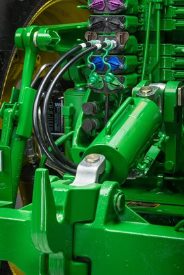 Hydraulic rear center-link
Hydraulic rear center-link
The 7R Series Tractors offer a Category 3 rear hydraulic center-link for all models. All wheel models of the 8R Series Tractor offer a Category 4 rear hydraulic center-link, in addition to a Category 3 center-link option for models 8295R and below.
The rear hydraulic center-link helps to ease the installation of hitch-mounted implements and makes fine adjustment of the top link effortless.
Center-link adjustments can be made in the field by using the control for the third selective control valve (SCV) or from the CommandCenter™ display. Adjustments may also be made using external controls on the rear fenders.
NOTE: These options are only compatible with fender extensions.
Front Hitch Chain Hooks - RE327692
Front Tow Point - R264789
Rear Hitch Premium Controls Upgrade Kit - BRE10144
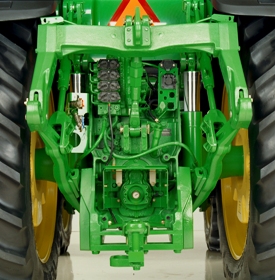 Category 3/3N Quik-Coupler
Category 3/3N Quik-Coupler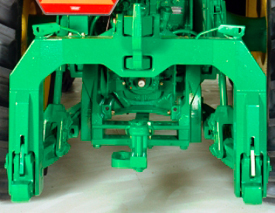 Category 4N/3 Quik-Coupler
Category 4N/3 Quik-CouplerThe Category 4N/3 and Category 3/3N cast Quik-Couplers provide increased clearance between an implement and the tractor’s tires, and allow fast and convenient attachment to implements.
 Hydraulic rear center-link
Hydraulic rear center-link
The 7R Series Tractors offer a Category 3 rear hydraulic center-link for all models. All wheel models of the 8R Series Tractor offer a Category 4 rear hydraulic center-link, in addition to a Category 3 center-link option for models 8295R and below.
The rear hydraulic center-link helps to ease the installation of hitch-mounted implements and makes fine adjustment of the top link effortless.
Center-link adjustments can be made in the field by using the control for the third selective control valve (SCV) or from the CommandCenter™ display. Adjustments may also be made using external controls on the rear fenders.
NOTE: These options are only compatible with fender extensions.
Scraper drawbar (quick hitch) - BXT10026
Scraper drawbar (universal) - BXT10027
Hydraulics
2nd Front Hitch SCV Kit - BRE10165
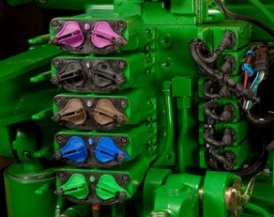 Five remote SCVs
Five remote SCVsThe field-installed electronic SCV kits are made available for tractors needing additional SCVs. These kits provide metered flow rates and timed detents with pressure and load sense compensation. The additional SCV(s) can also be integrated into the Headland Management System.
The field-installed kit includes International Organization for Standardization (ISO) lever-assisted breakaway couplers and armrest control lever.
 Five remote SCVs
Five remote SCVsThe field-installed electronic SCV kits are made available for tractors needing additional SCVs. These kits provide metered flow rates and timed detents with pressure and load sense compensation. The additional SCV(s) can also be integrated into the Headland Management System.
The field-installed kit includes International Organization for Standardization (ISO) lever-assisted breakaway couplers and armrest control lever.
The 7R and 8R Series Tractors offer dual-line hydraulic trailer brakes, dual-line air trailer brakes, or dual-line air and dual-line hydraulic trailer brakes, which allow the tractor braking system to connect to implements with high-pressure air or hydraulic brakes. Both systems automatically balance the brake pressure of both the tractor and implement to provide comfortable braking performance.
Trailer brake settings are fully customizable by adjusting gain and pre-brake settings. Trailer brake gain will give customers the ability to adjust how aggressive the trailer brakes are as the tractor brake pedal is depressed. Pre-brake adjustment will allow operators to adjust when the brakes are initiated in reference to the tractor brake pedal being depressed. This along with AutoClutch™ system settings will help the operator achieve optimum braking performance of both tractor and implement. Operators will also be able to test the trailer brake park release while the tractor is still in park during connecting and pre-trip activities.
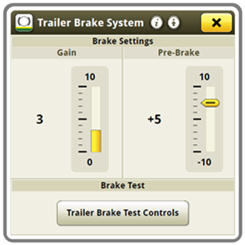

Factory options include dual-line hydraulic trailer brakes, dual-line air trailer brakes, or dual-line air and dual-line hydraulic trailer brake systems. The dual-line hydraulic trailer brake option is also available as a field-installed kit.
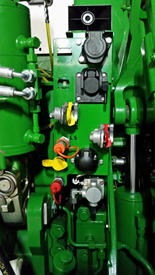 Trailer brake connections – 8R shown
Trailer brake connections – 8R shown Air trailer brake tank and dryer – 8R shown
Air trailer brake tank and dryer – 8R shown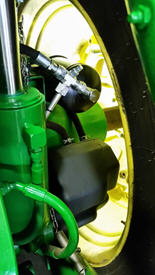 Air trailer brake tank – 8R shown
Air trailer brake tank – 8R shownDual-line hydraulic trailer brake system
Permits the use of hydraulic trailer brakes on the tractor. This system connects directly to the tractor’s hydraulic circuit and does not require the use of an auxiliary oil reservoir.
Hydraulic trailer brake system includes:
- Rear tractor line hydraulic couplers
Dual-line air trailer brake system
Permits the use of air trailer brakes on the tractor.
Air trailer brake system includes:
- Compressor
- Tank
- Air dryer
- Control valves
- Two line couplers
CAUTION: The agricultural tractor air trailer brake system is designed for use only with agricultural implements and agricultural trailers. This system is not compatible with the air trailer brake system used by over-the-road vehicles and does not conform to the standards established for over-the-road air trailer brake contamination and electrical systems.
Dual-line air and dual-line hydraulic trailer brake system
Permits the use of hydraulic or air brakes on the tractor. This system connects directly to the tractor’s hydraulic circuit and does not require the use of an auxiliary oil reservoir.
Air and hydraulic trailer brake system includes:
- Compressor
- Tank
- Air dryer
- Control valves
- Two line couplers
- Rear tractor line hydraulic couplers
CAUTION: The agricultural tractor air trailer brake system is designed for use only with agricultural implements and agricultural trailers. This system is not compatible with the air trailer brake system used by over-the-road vehicles and does not conform to the standards established for over-the-road air trailer brake contamination and electrical systems.
Easy hookup of planters and other implements
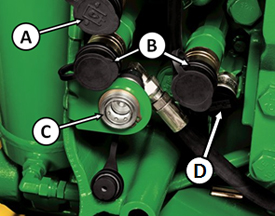 Auxiliary hydraulic couplers
Auxiliary hydraulic couplers
A – Pressure coupler
B – Motor return
C – Load sense
D – Case drain
To assist hooking up large equipment where multiple connections are required, factory-installed auxiliary hydraulic couplers are available.
Auxiliary sump coupler
The sump coupler kit allows oil to return from the hydraulics motor at low pressures. This coupler is required for correct attachment to current-production seeding products with case drain lines. The connector in the sump port is not to be used to carry return flow from a function to the tractor.
This coupler is required for correct attachment to current-production seeding products with case drain lines.
Hydraulic motor return couplers
The hydraulic motor return couplers can be used as couplers for return oil flow, from hydraulic orbital motors and other devices, to the tractor's low-pressure return port, labeled R on the tractor.
Use of this connector specifically in the return to sump port position is for hydraulic components that require a leak-off line connection to the tractor. Components and implements that require this typically are larger orbital motors that require a drain for seal protection. The connector in the sump port is not to be used to carry return flow from a function to the tractor.
Power beyond couplers
Power beyond provides live hydraulic power to equipment. This kit supplies oil pressure to implements when the engine is running.
Any implement using power beyond must have a way to control oil flow. Use an independent control valve that is pressure-and-flow compensating (supplied separately) to control the oil flow rate from this coupler set. Power-beyond functions require a load-sense signal to regulate pump pressure, therefore, a load-sense hydraulic line is used. Certain equipment may require modification.
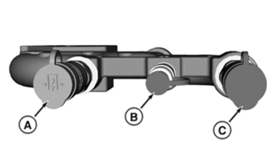 Optional auxiliary hydraulic equipment (9R shown)
Optional auxiliary hydraulic equipment (9R shown)
The auxiliary hydraulic optional equipment includes the following:
A – Pressure coupler
B – Load sense coupler
C – Return coupler (motor return)
Easy hookup of planters and other implements
 Auxiliary hydraulic couplers
Auxiliary hydraulic couplers
A – Pressure coupler
B – Motor return
C – Load sense
D – Case drain
To assist hooking up large equipment where multiple connections are required, factory-installed auxiliary hydraulic couplers are available.
Auxiliary sump coupler
The sump coupler kit allows oil to return from the hydraulics motor at low pressures. This coupler is required for correct attachment to current-production seeding products with case drain lines. The connector in the sump port is not to be used to carry return flow from a function to the tractor.
This coupler is required for correct attachment to current-production seeding products with case drain lines.
Hydraulic motor return couplers
The hydraulic motor return couplers can be used as couplers for return oil flow, from hydraulic orbital motors and other devices, to the tractor's low-pressure return port, labeled R on the tractor.
Use of this connector specifically in the return to sump port position is for hydraulic components that require a leak-off line connection to the tractor. Components and implements that require this typically are larger orbital motors that require a drain for seal protection. The connector in the sump port is not to be used to carry return flow from a function to the tractor.
Power beyond couplers
Power beyond provides live hydraulic power to equipment. This kit supplies oil pressure to implements when the engine is running.
Any implement using power beyond must have a way to control oil flow. Use an independent control valve that is pressure-and-flow compensating (supplied separately) to control the oil flow rate from this coupler set. Power-beyond functions require a load-sense signal to regulate pump pressure, therefore, a load-sense hydraulic line is used. Certain equipment may require modification.
 Optional auxiliary hydraulic equipment (9R shown)
Optional auxiliary hydraulic equipment (9R shown)
The auxiliary hydraulic optional equipment includes the following:
A – Pressure coupler
B – Load sense coupler
C – Return coupler (motor return)
 Hydraulic oil auxiliary reservoir kit
Hydraulic oil auxiliary reservoir kit
The auxiliary reservoir kit for the model year 2014 and newer 8R Series Wheel Tractors holds 50 L (13.2 gal.) of oil, providing a total hydraulic oil capacity of 90 L (23.8 gal.). This additional volume helps ensure that the tractor has enough hydraulic oil for applications using large single-acting cylinders or needing large hydraulic oil flow in a short period of time.
The reservoir is available as a factory and field-installed kit to meet the needs of specific applications and is not needed for ordinary hydraulic operations.
Front Hitch Hydraulic Motor Return Kit - BRE10171
The 7R and 8R Series Tractors offer dual-line hydraulic trailer brakes, dual-line air trailer brakes, or dual-line air and dual-line hydraulic trailer brakes, which allow the tractor braking system to connect to implements with high-pressure air or hydraulic brakes. Both systems automatically balance the brake pressure of both the tractor and implement to provide comfortable braking performance.
Trailer brake settings are fully customizable by adjusting gain and pre-brake settings. Trailer brake gain will give customers the ability to adjust how aggressive the trailer brakes are as the tractor brake pedal is depressed. Pre-brake adjustment will allow operators to adjust when the brakes are initiated in reference to the tractor brake pedal being depressed. This along with AutoClutch™ system settings will help the operator achieve optimum braking performance of both tractor and implement. Operators will also be able to test the trailer brake park release while the tractor is still in park during connecting and pre-trip activities.


Factory options include dual-line hydraulic trailer brakes, dual-line air trailer brakes, or dual-line air and dual-line hydraulic trailer brake systems. The dual-line hydraulic trailer brake option is also available as a field-installed kit.
 Trailer brake connections – 8R shown
Trailer brake connections – 8R shown Air trailer brake tank and dryer – 8R shown
Air trailer brake tank and dryer – 8R shown Air trailer brake tank – 8R shown
Air trailer brake tank – 8R shownDual-line hydraulic trailer brake system
Permits the use of hydraulic trailer brakes on the tractor. This system connects directly to the tractor’s hydraulic circuit and does not require the use of an auxiliary oil reservoir.
Hydraulic trailer brake system includes:
- Rear tractor line hydraulic couplers
Dual-line air trailer brake system
Permits the use of air trailer brakes on the tractor.
Air trailer brake system includes:
- Compressor
- Tank
- Air dryer
- Control valves
- Two line couplers
CAUTION: The agricultural tractor air trailer brake system is designed for use only with agricultural implements and agricultural trailers. This system is not compatible with the air trailer brake system used by over-the-road vehicles and does not conform to the standards established for over-the-road air trailer brake contamination and electrical systems.
Dual-line air and dual-line hydraulic trailer brake system
Permits the use of hydraulic or air brakes on the tractor. This system connects directly to the tractor’s hydraulic circuit and does not require the use of an auxiliary oil reservoir.
Air and hydraulic trailer brake system includes:
- Compressor
- Tank
- Air dryer
- Control valves
- Two line couplers
- Rear tractor line hydraulic couplers
CAUTION: The agricultural tractor air trailer brake system is designed for use only with agricultural implements and agricultural trailers. This system is not compatible with the air trailer brake system used by over-the-road vehicles and does not conform to the standards established for over-the-road air trailer brake contamination and electrical systems.
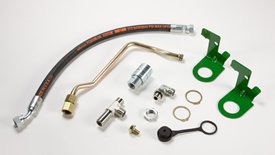 Auxiliary hitch lift assist kit
Auxiliary hitch lift assist kit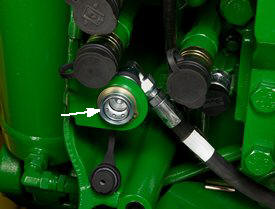 Auxiliary hitch lift assist
Auxiliary hitch lift assistLift assist wheels are often used with heavy 3-point-hitch-mounted implements. The hitch auxiliary raise kit provides hydraulic power for use with the lift assist wheels. Turning and transport are made easier using this feature.
Hydraulic Motor Case Drain (Flush Face Coupler) Kit - BRE10281
Hydraulic trailer brakes provide modulated braking of trailers equipped with hydraulic brakes for controlled braking.
- Connects directly to the tractor's hydraulic system
- Does not require a separate oil reservoir
The hydraulic trailer-brake kit provides the necessary components required by the braking system to hook up to an implement with high-pressure hydraulic brakes. This is achieved by scaling the tractor brake pressure to a corresponding trailer brake pressure in order to try to balance the braking performance as close as possible. A field-installed option is available for hydraulic brakes.
Hydraulic trailer brakes are available as either a factory-installed or a field-installed option.
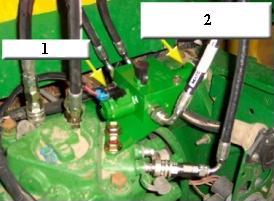 Low standby pressure kit
Low standby pressure kitThe field-installed kit provides easy installation and operation of equipment using power beyond. After installing this kit, you will be able to manually adjust the standby pressure of the tractor to the application and electronically turn the load sense signal on or off from the cab.
Always turn the load sense signal off when starting the tractor. Turning the load sense signal off will keep the pump at low standby pressure while cranking the tractor.
As a further benefit, when the power-beyond application is not needed, the valve can be turned off, reducing power needed to operate the hydraulic pump and lowering fuel consumption.
- Solenoid
- Manual pressure adjustment
RESERVOIR KIT, ADDITIONAL OIL TAKEOUT - BRE10309
Lighting
Xenon HID lights improve nighttime visibility
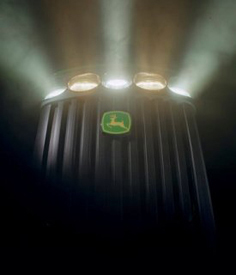 HID lights
HID lights John Deere has taken advantage of advanced lighting technology. This lighting provides the operator with industry-leading performance in nighttime visibility.
The important part of the system is the use of Xenon high-intensity discharge (HID) bulbs. These bulbs provide extreme brightness and a daylight color output for excellent definition of the field. The performance of this system allows the operator to easily view as much as 250 percent farther ahead, compared to previous tractors. A further benefit is there are no filaments in the HID bulb. Bulb life is increased by as much as 10 times vs. filament-style bulbs.
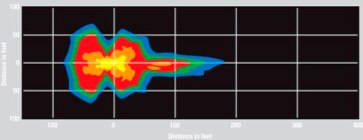 Standard lighting
Standard lighting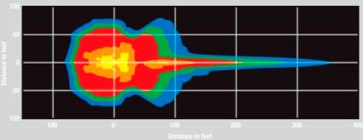 FieldVision lighting
FieldVision lightingFront FieldVision lighting
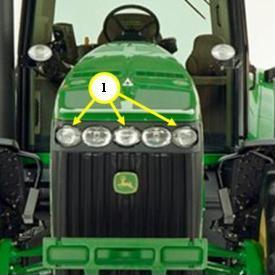 Front HID locations
Front HID locations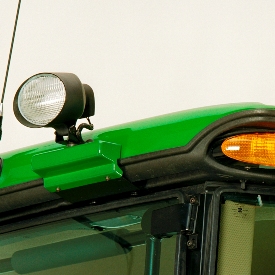 Roof lighting location
Roof lighting locationThe front lighting package adds three high-intensity discharge (HID) lights to the front grille (see 1 in the image above). To further enhance all-around tractor lighting, there are two additional 65-W halogen work lights added to the left- and right-hand cab roof.
The center of the bulb has a semi-spot lens, and the outer light housings have a flood lens. In row-crop, the operator will notice there is a longer beam of light in the center for following marker furrows. The overall width of the lighting pattern for a non-row-crop operation will be obvious so tilled or seeded passes are easily identified. The inner, larger-diameter light assemblies are used for road transport and use conventional halogen 60-/55-W H4 bulbs. These larger light housings are also used in the base lighting system. With the dual-wattage H4 bulb, the operator will notice that there is a true automotive-style high/low function when operating in the road position.
The cab roof lights can be adjusted to aim to the side or rear of the tractor.
Rear FieldVision lighting
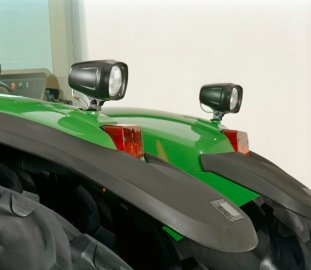 Rear FieldVision HID lighting
Rear FieldVision HID lightingThe premium HID lighting package (code 1720) adds two adjustable-position HID lights on the rear fenders.
Unlike aftermarket lights where the operating ballast is integral, these lights use a smaller housing with remote-mounted ballast. The smaller housing decreases obstruction for a clear view looking out the rear window. Using the light’s wide-angle flood lens will make it much easier to monitor the widest or longest equipment available.
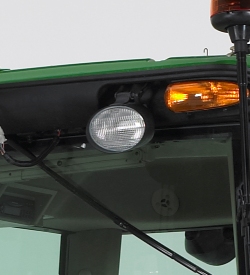 Front roof-mounted floodlights
Front roof-mounted floodlights Side roof-mounted floodlights
Side roof-mounted floodlightsNighttime visibility can be improved on tractors with two roof-mounted front floodlights or two roof-mounted side floodlights.
For additional transport visibility, install a rotary beacon light.
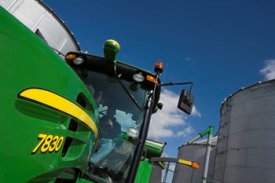 Rotary beacon light installed on 7030
Rotary beacon light installed on 7030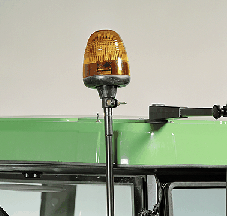 Rotary beacon light installed on 7020
Rotary beacon light installed on 7020Option code 9779 on the 7030 Series Large-Frame Tractors includes the rotary beacon light. The light features a fully-adjustable, double-clamp design that provides a more rigid vertical support stem.
Rotary beacon lights can be installed for additional transport visibility and commercial or governmental applications. The rotating, high-intensity light rests securely within an amber-colored lens.
The rotary beacon light is installed to meet requirements in commercial or governmental applications. The rotating, high-intensity light rests securely within an amber-colored safety lens. Both the light and lens are replaceable if damaged.
The rotary beacon light features a fully adjustable, double-clamp design that provides a more rigid vertical support stem.
The rotary beacon light is installed to meet requirements in commercial or governmental applications. The rotating, high-intensity light rests securely within an amber-colored safety lens. Both the light and lens are replaceable if damaged.
The rotary beacon light features a fully adjustable, double-clamp design that provides a more rigid vertical support stem.
Miscellaneous
With loads of capacity, two removable shelves, and an innovative front door and lid design, this new tractor utility box breaks new ground for convenience, versatility, and rugged design. Grease guns, tow chains, hitch pins, and many other essential items can be stored safely and can be easily accessed, putting an end to cluttered cabs.
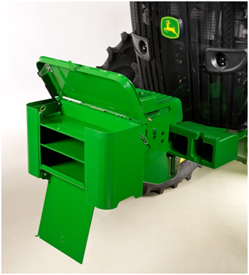 Front utility box
Front utility box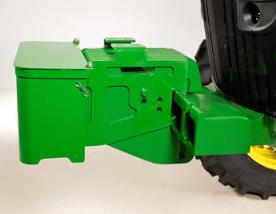 Front utility box and bracket
Front utility box and bracketBuilt from welded, heavy-gauge sheet steel, this new box offers long-term durability not seen with other toolboxes. A heavy-duty gas strut on the lid and locking pins make opening and locking simple and easy.
Specifications:
- Made in the USA
- 23 in. x 8 in. x 12 in.
- Two removable shelves
- Heavy-duty construction
- Fold down front door for easy access
- Mount with existing R127764 tractor weights using BRE10153 bracket
- Mount on 9X30 Series Wheel Tractors (front left side) using BRE10291 bracket
With loads of capacity, two removable shelves, and an innovative front door and lid design, this new tractor utility box breaks new ground for convenience, versatility, and rugged design. Grease guns, tow chains, hitch pins, and many other essential items can be stored safely and can be easily accessed, putting an end to cluttered cabs.
 Front utility box
Front utility box Front utility box and bracket
Front utility box and bracketBuilt from welded, heavy-gauge sheet steel, this new box offers long-term durability not seen with other toolboxes. A heavy-duty gas strut on the lid and locking pins make opening and locking simple and easy.
Specifications:
- Made in the USA
- 23 in. x 8 in. x 12 in.
- Two removable shelves
- Heavy-duty construction
- Fold down front door for easy access
- Mount with existing R127764 tractor weights using BRE10153 bracket
- Mount on 9X30 Series Wheel Tractors (front left side) using BRE10291 bracket
StarFire 6000 Locking Bracket - BPF11074
Operator Environment
Power strip and accessories
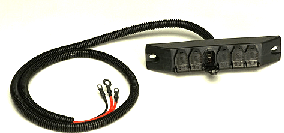 Power strip kit
Power strip kit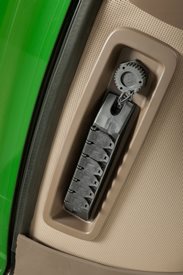 Power strip installed
Power strip installedThe power strip provides six additional electrical outlets that give either permanent or ignition-key-controlled power for such items as:
- Computers
- Portable telephone chargers
- Implement monitor
- Implement supply
- 12-V and up to 30-amp total current can be taken from these outlets
The power strip is not a surge suppressor. Electrical equipment with program memory or capacity for data storage requires protection from the damage of electrical surges and spikes that could occur in systems without transient voltage protection.
Electrical power accessories
 Power strip installed
Power strip installed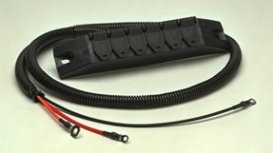 Power strip
Power stripAn electrical power strip can be installed on tractors not equipped, providing six additional outlets for powering monitors or other electrical equipment.
Three different adapters may be ordered separately through Parts.
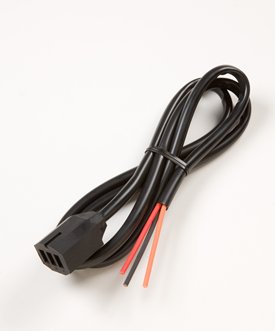 Electrical cord
Electrical cord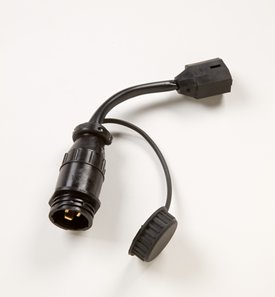 Three-way convenience adapter
Three-way convenience adapter- The 3-ft electrical cord is used for hardwiring electrical components to be used with the power strip. The power strip end has a standard connector.
- The three-way convenience adapter allows three pin electrical connections to be adapted for use with the power strip.
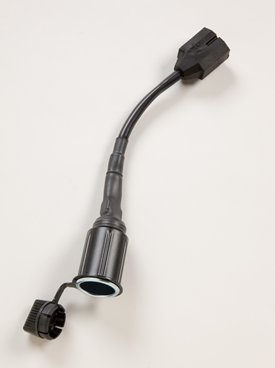 Cigar lighter outlet adapter
Cigar lighter outlet adapter
- The cigar lighter outlet adapter can be used for plugging in items such as car charges for cell phones or MP3 players. It does not include a lighter.
Antenna Mount and Wiring for Business Band (2-Way) Radio - RE269615
Ash Tray - RE275532
Carpet with foot throttle - RE346238
Carpet without foot throttle - RE556830
Electrical power accessories
 Power strip installed
Power strip installed Power strip
Power stripAn electrical power strip can be installed on tractors not equipped, providing six additional outlets for powering monitors or other electrical equipment.
Three different adapters may be ordered separately through Parts.
 Electrical cord
Electrical cord Three-way convenience adapter
Three-way convenience adapter- The 3-ft electrical cord is used for hardwiring electrical components to be used with the power strip. The power strip end has a standard connector.
- The three-way convenience adapter allows three pin electrical connections to be adapted for use with the power strip.
 Cigar lighter outlet adapter
Cigar lighter outlet adapter
- The cigar lighter outlet adapter can be used for plugging in items such as car charges for cell phones or MP3 players. It does not include a lighter.
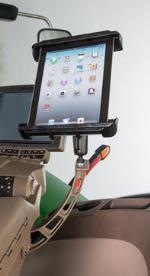 CommandARM bracket
CommandARM bracket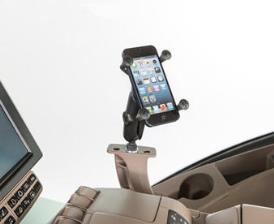 CommandARM bracket
CommandARM bracketThe CommandARM bracket for Final Tier 4 (FT4) tractors offers a convenient way to mount a cell phone or tablet to the CommandARM for easy use of a mobile device. This bracket is not compatible with joystick-equipped tractors.
NOTE: Cell phone, tablet, and Ram mount hardware sold separately.
NOTE: This bracket is not compatible with joystick-equipped tractors.
Cornerpost Display Bracket - PF90385
Display Harness - GS2 / GS3 Display with Video to GreenStar (Round) Cornerpost (30 in. / 762 mm) - PFP12435
Ethernet Adapter Cable (Square to Round - 2.5 ft. / .8m) - PFP12950
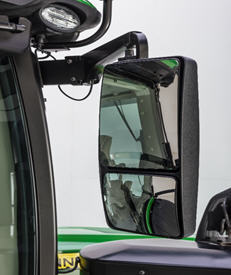 Right-hand mirror shown on 8RT Series Tractor
Right-hand mirror shown on 8RT Series Tractor7R and 8R Series Tractor mirror options
- Manually adjustable, single pane
- Wide angle, heated, electrically adjustable top pane, manual telescoping
- Wide angle, heated, electrically adjustable top pane, electrically telescoping
8RT Series Tractor mirror options
- Manually adjustable, single pane
- Wide angle, heated, electrically adjustable top pane, manual telescoping
9R and 9RX Series Tractor mirror options
- Manually adjustable, single pane
- Wide angle, heated, electrically adjustable top pane, manual telescoping
- Wide angle, heated, electrically adjustable top pane, electrically telescoping
9RT Series Tractor mirror options
- Manually adjustable, single pane
- Wide angle, heated, electrically adjustable top pane, manual telescoping
The electrically adjustable mirrors on both sides of the cab are handy to assist in getting the view needed of variable-width implements, wagons, or carts.
Field-installed kits are also available to convert a manual mirrors to electrically adjustable. See the attachment section for further information.
NOTE: Electrically telescoping mirrors are not compatible with 8RT and 9RT Tractors.
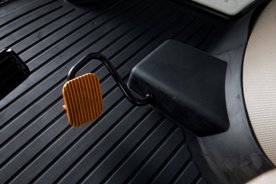 Foot-operated speed control (8R Series)
Foot-operated speed control (8R Series)The foot-operated speed control increases productivity of the tractor/operator unit by allowing the operator better control of engine speed for loader work, maneuvering in tight spaces, and transport. This option provides the operator excellent modulation of engine speed on wheel tractors.
Infinitely Variable Transmission (IVT™) equipped tractors can have an automotive-type operation with the use of foot throttle. This is especially useful in transport applications. Foot throttle and AutoClutch™ clutch action of the transmission are easily coordinated by the operator for smooth operation.
Electrical power accessories
 Power strip installed
Power strip installed Power strip
Power stripAn electrical power strip can be installed on tractors not equipped, providing six additional outlets for powering monitors or other electrical equipment.
Three different adapters may be ordered separately through Parts.
 Electrical cord
Electrical cord Three-way convenience adapter
Three-way convenience adapter- The 3-ft electrical cord is used for hardwiring electrical components to be used with the power strip. The power strip end has a standard connector.
- The three-way convenience adapter allows three pin electrical connections to be adapted for use with the power strip.
 Cigar lighter outlet adapter
Cigar lighter outlet adapter
- The cigar lighter outlet adapter can be used for plugging in items such as car charges for cell phones or MP3 players. It does not include a lighter.
Sound systems provide powerful performance with four-speaker system
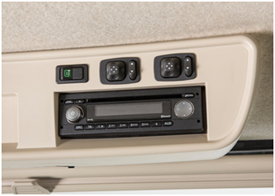 Radio with CD player shown
Radio with CD player shown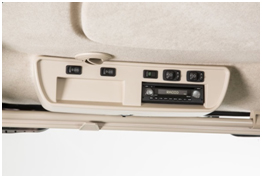 Bosch radio
Bosch radioThe John Deere/Bosch radios are available with or without a compact disc (CD) player.
The system also features:
|
For clear reception, an external antenna is included.
Bosch is a trademark of Robert Bosch GmBH. Bluetooth is a trademark of Bluetooth SIG Incorporated. XM is a trademark of XM Satellite Radio Incorporated.
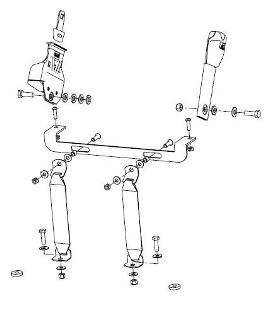 Seat belt for 8R Series Tractors
Seat belt for 8R Series TractorsThe 3-in. field-installed seat belt kit is designed for use with the 8R and 8RT Series Tractor operator seats. The seat belt kit is offered to meet regulations that require a seat belt anchorage force similar to the SAE J386 (including previous versions up to 22.2 kN anchorage strength), IOS 6683, and OSHA requirements (29CFR1926.602) for earthmoving operations and non-agricultural tractor operations.
NOTE: John Deere recommends reviewing the seat belt kit performance capabilities to ensure compliance with local, state, regional, and national requirements.
A favorite worldwide, the RAM self-leveling cup holder is now available as a kit - designed specifically for Deere equipment. It is easily installed to keep your favorite beverage upright even in the roughest terrain. The perfect accessory for any cab that has 10-mm mounting bosses.
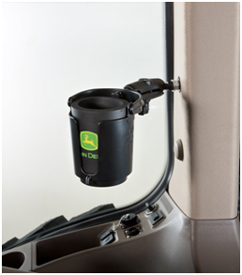 Self-leveling cup holder John Deere branded beverage insulator included
Self-leveling cup holder John Deere branded beverage insulator included
The new cup holder features a unique self-leveling design. This pivoting design allows easy adjustment for the holder while offsetting motion of the vehicle when moving.
Features and applications:
- Self-leveling action reduces spills
- Durable design for rough environments
- Easy adjustable mounting for ideal placement
- Includes John Deere branded beverage insulator
- Compatible with most monitor brackets and all 10-mm threaded bosses
Single Lever Multi Function Joystick - BRE10143
Electrical power accessories
 Power strip installed
Power strip installed Power strip
Power stripAn electrical power strip can be installed on tractors not equipped, providing six additional outlets for powering monitors or other electrical equipment.
Three different adapters may be ordered separately through Parts.
 Electrical cord
Electrical cord Three-way convenience adapter
Three-way convenience adapter- The 3-ft electrical cord is used for hardwiring electrical components to be used with the power strip. The power strip end has a standard connector.
- The three-way convenience adapter allows three pin electrical connections to be adapted for use with the power strip.
 Cigar lighter outlet adapter
Cigar lighter outlet adapter
- The cigar lighter outlet adapter can be used for plugging in items such as car charges for cell phones or MP3 players. It does not include a lighter.
Sound systems provide powerful performance with four-speaker system
 Radio with CD player shown
Radio with CD player shown Bosch radio
Bosch radioThe John Deere/Bosch radios are available with or without a compact disc (CD) player.
The system also features:
|
For clear reception, an external antenna is included.
Bosch is a trademark of Robert Bosch GmBH. Bluetooth is a trademark of Bluetooth SIG Incorporated. XM is a trademark of XM Satellite Radio Incorporated.
The left-hand step mud guard is intended for use with the full-coverage rear fender. The left-hand step mud guard is provided with G49 rear tires.
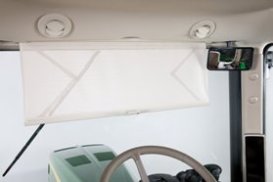 Front pull-down sun shade
Front pull-down sun shade
The pull-down shade for the front windshield improves operator visibility on sunny days by blocking the sun's bright light and reducing glare. The pull-down sunshade allows the operator flexibility in the amount of window coverage desired through an infinitely adjustable range of movement and more positive friction detents found in a scissors-style linkage.
The sun shade is included in all CommandView™ III cabs.
 Front pull-down sun shade
Front pull-down sun shade
The pull-down shade for the front windshield improves operator visibility on sunny days by blocking the sun's bright light and reducing glare. The pull-down sunshade allows the operator flexibility in the amount of window coverage desired through an infinitely adjustable range of movement and more positive friction detents found in a scissors-style linkage.
The sun shade is included in all CommandView™ III cabs.
Tablet Mount Kit - BRE10255
Operator's Station
Cell phones, tablets, and other devices are key tools for farming today. John Deere has now made it easier than ever to incorporate these tools into the operator's station.
Stay connected with the RAM® cell phone and tablet mounts. John Deere offers a vast selection of adjustable accessory mounting solutions and media devices to fit every need and application.
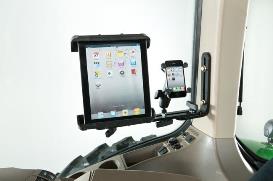 Mounting bracket with cell phone and tablet mount
Mounting bracket with cell phone and tablet mount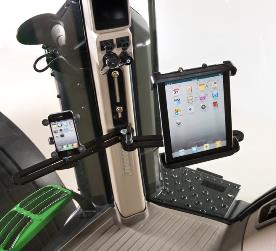 Mounting bracket with cell phone and tablet mount
Mounting bracket with cell phone and tablet mount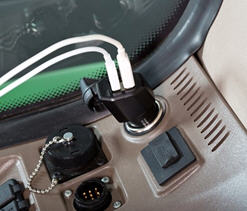 USB charger simultaneously charging two devices
USB charger simultaneously charging two devices
Features:
- Dual USB sockets give more options for in cab devices
- 4.2A output to simultaneously charge two tablets or other USB devices
- Sleek, compact design reduces clutter in the cab
- Blue light-emitting diode (LED) indicator informs that power is on
RAM is a trademark of National Products Inc.
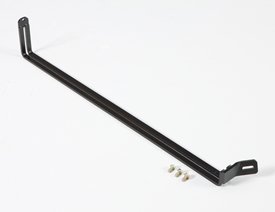 Accessories mounting bracket
Accessories mounting bracket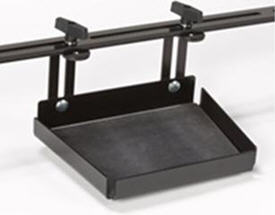 Tray kit
Tray kitThe accessories bracket is available for mounting monitors, phones, radios, and other accessories in one convenient location.
The bracket connects in the existing holes inside the cab.
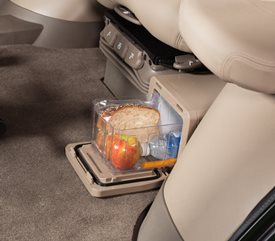 CommandView™ III cab refrigerator
CommandView™ III cab refrigerator
The optional refrigerator, available for standard or premium cab models, offers improved operator comfort and accommodation. Located to the left of the operator’s seat, the refrigerator provides ample cooling capacity to keep food and beverages fresh. The large-capacity slide-out tray eases loading, unloading, and cleaning. The refrigerator is activated by turning the key to the on position or starting the tractor, and shuts off when the key is turned off.
Cell phones, tablets, and other devices are key tools for farming today. John Deere has now made it easier than ever to incorporate these tools into the operator's station.
Stay connected with the RAM® cell phone and tablet mounts. John Deere offers a vast selection of adjustable accessory mounting solutions and media devices to fit every need and application.
 Mounting bracket with cell phone and tablet mount
Mounting bracket with cell phone and tablet mount Mounting bracket with cell phone and tablet mount
Mounting bracket with cell phone and tablet mount USB charger simultaneously charging two devices
USB charger simultaneously charging two devices
Features:
- Dual USB sockets give more options for in cab devices
- 4.2A output to simultaneously charge two tablets or other USB devices
- Sleek, compact design reduces clutter in the cab
- Blue light-emitting diode (LED) indicator informs that power is on
RAM is a trademark of National Products Inc.
 Right-hand mirror shown on 8RT Series Tractor
Right-hand mirror shown on 8RT Series Tractor7R and 8R Series Tractor mirror options
- Manually adjustable, single pane
- Wide angle, heated, electrically adjustable top pane, manual telescoping
- Wide angle, heated, electrically adjustable top pane, electrically telescoping
8RT Series Tractor mirror options
- Manually adjustable, single pane
- Wide angle, heated, electrically adjustable top pane, manual telescoping
9R and 9RX Series Tractor mirror options
- Manually adjustable, single pane
- Wide angle, heated, electrically adjustable top pane, manual telescoping
- Wide angle, heated, electrically adjustable top pane, electrically telescoping
9RT Series Tractor mirror options
- Manually adjustable, single pane
- Wide angle, heated, electrically adjustable top pane, manual telescoping
The electrically adjustable mirrors on both sides of the cab are handy to assist in getting the view needed of variable-width implements, wagons, or carts.
Field-installed kits are also available to convert a manual mirrors to electrically adjustable. See the attachment section for further information.
NOTE: Electrically telescoping mirrors are not compatible with 8RT and 9RT Tractors.
Windshield wiper with washer, right-hand window - BRE10037
PTO
1-3/8 In. 1000 RPM shaft for use with Drawbar or 3-pt Hitch (flange) - R537790
35-mm (1-3/8-in.), 540-/1000-rpm PTO with built-in overload protection
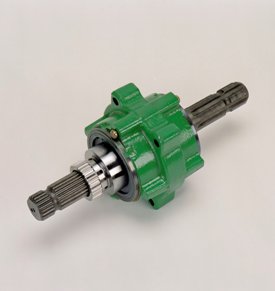 35-mm (1-3/8-in.), 1000/540 PTO and torque-limiting collar
35-mm (1-3/8-in.), 1000/540 PTO and torque-limiting collarThis bolt-on 35-mm (1-3/8-in.), 1000-rpm and 35-mm (1-3/8-in.), 540-rpm PTO unit is designed with built-in overload protection by using a torque-limiting collar that slides over the PTO shaft.
Ordering this kit provides all three shaft sizes shipped with the tractor. The 45-mm (1-3/4-in.), 1000-rpm PTO comes installed on the tractor, with a 35-mm (1-3/8-in.), 1000/540 PTO unit placed in the cab. This PTO kit provides complete implement versatility for high-horsepower tractors.
 Front PTO
Front PTO
For increased versatility, two 1000-rpm front PTO options are available from the factory for 7R and 8R Series Tractors equipped with the John Deere front hitch.
- Type 2, 1000-rpm (counterclockwise as seen from front), 35-mm (1 3/8-in.), 21-spline front PTO
- Type 3, 1000-rpm (counterclockwise as seen from front), 45-mm (1 3/4-in.), 20-spline front PTO
Front PTO features include:
- The ability to be incorporated with iTEC™ sequences
- Three choices of engagement modulation: auto, low, and high
- Integrated controls
- Cornerpost display indicators
- Bolt-on shaft makes it easy to change shafts if necessary.
- Remote PTO engagement
7R-specific features:
- 130 kW (175 hp)
- Integrated with all transmissions
- PTO disconnect for efficiency
- Requires TLS front axle
8R-specific features:
- 112 kW (150 hp)
- Integrated with the infinitely variable transmission (IVT™)
- Requires Independent-Link Suspension (ILS™) with front brakes
Intelligent Power Management (IPM)
IPM is compatible with 7R and 8R Series Tractors equipped with a front PTO option. The front PTO, rear PTO, or transport speeds can activate IPM on 7R Tractors. However, on 8R Tractors, IPM is only activated by the rear PTO or by transport speeds. For example:
- A front snow blower will not benefit from IPM on an 8R since the front PTO alone will not activate IPM.
- A triple-mounted mower-conditioner will benefit from IPM as high power levels are transmitted via the rear PTO. The front mower-conditioner will have 150 hp available to it on an 8R, which is adequate to operate these mowers in most crop conditions.
- See Intelligent Power Management for more information
PTO disconnect on 7R Series Tractors
Disconnecting the PTO drive to the PTO box when not in use increases tractor efficiency by reducing:
- Power requirements, which saves nearly 70 percent of power required to run the PTO disengaged
- Wear on components of the PTO box; components are not moving when the PTO is disconnected
Refer to the operator’s manual for instructions on how to disconnect the PTO when not in operation.
Front PTO operation
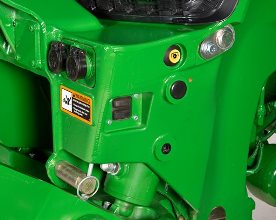 Remote control at front of tractor
Remote control at front of tractor 
Front PTO engagement is actuated through an engagement switch similar to the rear PTO located on the CommandARM™ controls.
- PTO clutch is electronically activated with automatic torque modulation.
- PTO modulation is selectable through the CommandCenter™ console and display.
- To activate the PTO remotely, select the remote PTO enable button in Generation 4 CommandCenter display, push down and forward on the FPTO switch in the cab and use the remote control at the front of the tractor.
NOTE: For the 8R Series, if the tractor is equipped with a front PTO, additional IPM power will transfer through the front PTO. However, IPM activation is only sensed through the rear PTO. Adequate load must be sensed on the rear PTO in order for IPM to activate.
 Front PTO
Front PTO
For increased versatility, two 1000-rpm front PTO options are available from the factory for 7R and 8R Series Tractors equipped with the John Deere front hitch.
- Type 2, 1000-rpm (counterclockwise as seen from front), 35-mm (1 3/8-in.), 21-spline front PTO
- Type 3, 1000-rpm (counterclockwise as seen from front), 45-mm (1 3/4-in.), 20-spline front PTO
Front PTO features include:
- The ability to be incorporated with iTEC™ sequences
- Three choices of engagement modulation: auto, low, and high
- Integrated controls
- Cornerpost display indicators
- Bolt-on shaft makes it easy to change shafts if necessary.
- Remote PTO engagement
7R-specific features:
- 130 kW (175 hp)
- Integrated with all transmissions
- PTO disconnect for efficiency
- Requires TLS front axle
8R-specific features:
- 112 kW (150 hp)
- Integrated with the infinitely variable transmission (IVT™)
- Requires Independent-Link Suspension (ILS™) with front brakes
Intelligent Power Management (IPM)
IPM is compatible with 7R and 8R Series Tractors equipped with a front PTO option. The front PTO, rear PTO, or transport speeds can activate IPM on 7R Tractors. However, on 8R Tractors, IPM is only activated by the rear PTO or by transport speeds. For example:
- A front snow blower will not benefit from IPM on an 8R since the front PTO alone will not activate IPM.
- A triple-mounted mower-conditioner will benefit from IPM as high power levels are transmitted via the rear PTO. The front mower-conditioner will have 150 hp available to it on an 8R, which is adequate to operate these mowers in most crop conditions.
- See Intelligent Power Management for more information
PTO disconnect on 7R Series Tractors
Disconnecting the PTO drive to the PTO box when not in use increases tractor efficiency by reducing:
- Power requirements, which saves nearly 70 percent of power required to run the PTO disengaged
- Wear on components of the PTO box; components are not moving when the PTO is disconnected
Refer to the operator’s manual for instructions on how to disconnect the PTO when not in operation.
Front PTO operation
 Remote control at front of tractor
Remote control at front of tractor 
Front PTO engagement is actuated through an engagement switch similar to the rear PTO located on the CommandARM™ controls.
- PTO clutch is electronically activated with automatic torque modulation.
- PTO modulation is selectable through the CommandCenter™ console and display.
- To activate the PTO remotely, select the remote PTO enable button in Generation 4 CommandCenter display, push down and forward on the FPTO switch in the cab and use the remote control at the front of the tractor.
NOTE: For the 8R Series, if the tractor is equipped with a front PTO, additional IPM power will transfer through the front PTO. However, IPM activation is only sensed through the rear PTO. Adequate load must be sensed on the rear PTO in order for IPM to activate.
Software Downloads
IPM
NOTE: IPM is only available for Tier 3/Stage IIIA, Interim Tier 4/Stage IIIB, Final Tier 4/Stage IV engines, and not for Stage II engines.
This feature is for many typical farming operations that use the rear power take-off (PTO) in high-power applications or the tractor as a transport vehicle. Operators who are looking for more power in non-stationary PTO and transport applications will be interested in the IPM feature.
In high rear PTO power applications such as forage harvesters, rototillers, and beet or potato harvesting equipment or where heavy trailers, carts, or implements are moved to and from various locations, this feature provides significant additional capabilities. The solution improves productivity with more consistent ground speeds, quicker acceleration, and the ability to better hold desired transport speeds.
This two-in-one tractor solution successfully operates in power-intensive PTO and transport applications at reasonable low fuel consumption without being disadvantaged by the higher weight, the bigger proportions, and the extra costs of the next higher horsepower model.
This feature is available as a factory- or field-installed option.
Tractor applications
 8R Tractor in transport
8R Tractor in transport
Rear PTO field applications
- Rear-mounted snow blowers
- Sugar beet harvesting
- Forage harvesters
- Potato harvesting
- Rotary cutters
- Mower conditioners
- Flail mowers
- Balers
- Soil stabilizing
- Power harrow
- Vegetable bed formers
- Muck spreaders
Transport applications
- Grain carts or wagons
- Slurry tanks
- Implement transport from field to field
- Pull-type sprayers
- Extensive operation in hills/roadways
This is not intended to be an inclusive list of all applications but shows the wide range of uses for additional engine horsepower.
Power available
IPM provides engine power increase in levels proportional to the size of the tractor. IPM provides a controlled power boost of up to 26 kW (35 engine hp) to tractor under the following operating conditions:
- Tractor moving and PTO under load
- Transport during acceleration
- Transport during deceleration
Power increase is not provided under draft applications or non-loaded rear PTO applications. Power increase is only provided when required.
How it works
There are specific operating parameters when IPM functions to boost engine power. It is the "intelligent" part of the system that provides seamless operation while adjusting the engine horsepower depending on how the tractor is being used. For engine horsepower boost activation, the tractor must already be running an application that is using the full power capability of the tractor.
PTO activation
Power must be sensed going through the PTO drive clutch by the tractor's electronic systems. The tractor must be moving at least 0.5 km/h (0.3 mph) and PTO consuming moderate power before power boost engages. The speeds shown above, assume lowest possible gear or speed setting and the engine running at 2100 rpm.
NOTE: If the tractor is equipped with a front PTO, additional IPM power will transfer through the front PTO. However, IPM activation is only sensed through the rear PTO. Adequate load must be sensed on the rear PTO in order for IPM to activate.
Tractor compatibility with additional power
IPM has been thoroughly tested by John Deere engineers to be compatible with the base tractor equipment with no impact to reliability. John Deere provides IPM as opposed to unapproved aftermarket devices that boost power without regard to engine, transmission, axles, and drawbar, or hitch capability.
This feature provides optimal utilization of tractor components. For example, with PTO operation, power goes through axles to move the tractor along the ground and turn the PTO shaft and implement. Adding power to both of these systems does not overload either one individually. At transport speeds, drive train torque load decreases significantly from levels seen at low field speeds. Adding power at transport does not overload transmissions or axles.
Aftermarket devices are not selective when power increases are available. Great amounts of power increase are promised with these devices. Large power changes are not compatible with base tractor equipment. To note, base tractor equipment changes as power increases. Larger parts, like hitches, drawbars, tire size, drive train components, axle diameters, and engine calibrations for emission performance and cooling, ensure durability of the total vehicle as power increases. Operating outside of the design capabilities of the tractor base equipment will have an impact on durability and reliability.
Transport activation
When in transport applications, power transition is smooth. The engine will respond seamlessly as load changes, such as when going up and down hills. Additional power is available at a useful working speed with minor differences between tractor models and transmissions.
The minimum ground speed is where additional power will begin to be applied, assuming the engine is already fully loaded. Ramp up to full additional power occurs as speed continues to increase. Full additional power occurs within a 3 mph (5 km/h) band.
Transport during acceleration: power boost occurs in steps through the range from 23 km/h – 28 km/h (14.3 mph – 17.4 mph).
Transport during deceleration: power boost ramps down in equal steps in the range from 23 km/h – 18 km/h (14.3 mph – 11.2 mph).
Power boost levels other than at rated rpm
Some operators will run the tractor at full loads and/or run transmissions in auto mode in transport. This means that the engine most likely will not be operating at rated rpm. As the engine is loaded, it will eventually drop off of rated rpm and use the power bulge as rpm slows. This is the way every John Deere PowerTech™ Plus engine operates when it is loaded to maximum power and torque.
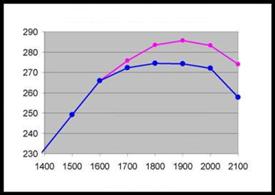 Usable rpm range of operation (8345R shown)
Usable rpm range of operation (8345R shown)
IPM (shown in purple in chart above versus standard power shown in blue) provides additional engine horsepower from rated engine speed down to approximately 1600 rpm (shown on the x-axis in image above, with power kilowatt shown in the y-axis), which is peak engine torque.
Horsepower levels are increased above base equipment power bulge values.
If the PTO is engaged and the engine rpm stays near rated speed of 2100 rpm, the full additional power potential for the tractor model will be available for use to handle additional load from the implement or changing terrain.
If the PTO is not in use and in transport operation, and the rpm has dropped off of rated speed, usable additional power boost of IPM will taper off as rpm decreases. The chart above (with 8345R Tractor power curves) shows the relationship of how much additional usable horsepower is available in the operating range. All tractors operate in a similar manner with this feature.
Operator visibility and control of operation
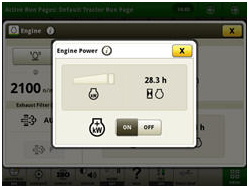 Engine power display
Engine power display
All tractors have the power meter display function as base equipment. The operator can observe when full capabilities of the tractor are being utilized. This function graphically displays power utilization up to rated horsepower and power bulge.
The power meter can be found in the CommandCenter™ display. If the engine is off or has minimal load, the power meter will not fill in. The meter is similar in concept to a cellular phone's signal-strength meter. As the power increases, it will fill in bars in an icon. The display will also show the level of additional power being used. The long section represents up to the rated power. The smaller section represents power bulge and is an indicator of additional power available with IPM.
Via the CommandCenter, there is also the ability to enable or disable the function. The operator's manual provides simple details about navigating the engine screen.
IPM is automatically enabled each time the tractor is started.
Transmission
 Ether valve and canister
Ether valve and canister Block heater
Block heaterThe optional cold start package is recommended for tractors frequently started at or below -6°C (21.2°F).
The kit includes factory-installed activation switch and ether valve with ether canister. A 110-V, high-wattage block heater and grounded cord are also included with the factory-installed option.
 Ether valve and canister
Ether valve and canister Block heater
Block heaterThe optional cold start package is recommended for tractors frequently started at or below -6°C (21.2°F).
The kit includes factory-installed activation switch and ether valve with ether canister. A 110-V, high-wattage block heater and grounded cord are also included with the factory-installed option.
Vandal Protection
Custom key door locks
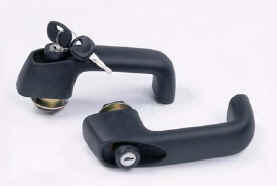 Custom key door lock kit
Custom key door lock kitField-installed kit (AL71345) allows for a door handle to be installed that has a key different from the tractor ignition key.
Weights
Front weights provide additional ballast for the front axle.
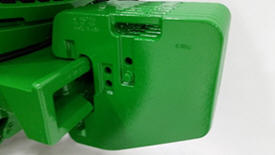 Front support with suitcase weights
Front support with suitcase weightsCast Quik-Tatch suitcase weights (R127764) can be added to provide additional ballast for implements that exert heavy draft loads and require additional ballast or with hitch-mounted implements that require additional ballast to maintain steering control while transporting.
These weights are Quik-Tatch weights that require minimal effort to attach.
Pick-up weights
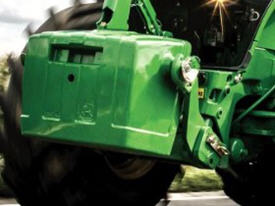 Pick-up weights
Pick-up weightsPick-up weights are design to add fast weight to the tractor. Following pick-up weights can be mounted at the front.
Support (base weight):
- Pick-up weight 900 kg
- Pick-up weight 1150 kg
All pick-up hitches can be mounted also at the rear in the 3-point hitch as a counter weight.
To use the third mounting point, an additional center-link bracket is available.
1500 kg and 1800 kg pick-up weights
The two weights differ only internally, therefore no external differences are visible.
The pick-up weights can either be installed on the rear hitch or on the front hitch of the tractor using the center-link bracket. They cannot be mounted directly on the front base weight. A front hitch is required. The center-link bracket for installation is included.
 New pick up weight attached on 6R
New pick up weight attached on 6R
The new shape of the 1500 kg and 1800 kg pick-up weights allows a quick and safe mounting.
This is ensured by an optimal alignment of the weight and the tractor along with a self-centering design.
Major benefits of the new design:
- Easy and comfortable
- Less time is required
- Lower risk of injury
Due to the user-friendliness, an optimal ballasting of the tractor is guaranteed at any time.
The performance of the tractor is used to a greater extent, which leads to higher productivity and a reduction in fuel consumption.
 Self-Centering of new pick-up weight
Self-Centering of new pick-up weight
The weights cannot be front installed in combination with Quik-Tatch front weights.
NOTE: Ballast should be limited by the lowest of either tire capacity or tractor capacity. The carrying capacity of each tire should not be exceeded. For more ballasting information refer to the operator's manual and ballast calculator.
For operators requiring additional ballast or additional traction on the rear axle
72-kg (159-lb), 205-kg (452-lb), 625-kg (1378-lb), and 970-kg (2138-lb) cast rear-wheel weights are available for the 7R and 8R Series Tractors. The attaching hardware for all rear-wheel weight options may be ordered through parts.
The range of rear-wheel weights can provide the proper amount of rear axle ballast for a variety of applications. The addition of this ballast will increase traction on the rear axle of the tractor. These weights can also be used to counterbalance the effect of adding additional weight on the front axle in the form of a front weight support, front hitch, front spray tanks, and front-end loaders.
72-kg (159-lb) starter weight
The 72-kg (159-lb) cast rear-wheel weight is offered individually as attachment R167153. This weight can be used either as an inner or outer rear-wheel weight. The 72-kg (159-lb) weight can be used by itself or as a starter weight for the 205-kg (452-lb) rear-wheel weights.
205-kg (452-lb) weight
The 205-kg (452-lb) cast rear-wheel weight is offered individually as attachment R07782. The 72-kg (159-lb) starter weight (R167153) must be installed prior to the 205-kg (452-lb) weight on rear steel wheels. This practice is optional on cast wheels; however, most weight packages will be configured this way.
625-kg (1378-lb) weight
R167151 includes one 625-kg (1378-lb) cast inner rear-wheel weight. This weight is to be used on the inside of the rear wheel assembly. This option can be stacked on a double-flat cast hub, with a 70-kg (154-lb) starter ring on the outside.
70-kg (154-lb) weight
BRE10026 features a 70-kg (154-lb) starter weight. The starter weight and guide lugs provide improved installation and removal of the 900-kg (1984-lb) weight. This weight can be used individually on the outside of the steel, dual rims on rack-and-pinion axles, or on the outside of the double-flat, single-taper wheel hub. For the approved cast hubs, can also be used with the inner cast weights as well.
NOTE: Use on the outer side of approved cast hubs will limit dual tire and spacing capability.
900-kg (1984-lb) weight
Individual R341378 900-kg (1984-lb) weights ordered through Parts. The 70-kg (154-lb) starter weight is required for installation, and provides guide lugs for improved installation and removal of the 900-kg (1984-lb) weight. 900-kg (1984-lb) weight ballast option is compatible with steel, dual wheels with rim diameters of 106.7, 116.8 cm, or 127 cm (42 in., 46 in., 50 in., or 54 in.). This allows the weights to be added to only the outer rear dual on a rack-and-pinion axle and double-flat axle with single-taper hub.
NOTE: This weight option is not compatible with 96.5-cm or 137.2-cm (38-in. or 54-in.) wheels.
Front weights provide additional ballast for the front axle.
 Front support with suitcase weights
Front support with suitcase weightsCast Quik-Tatch suitcase weights (R127764) can be added to provide additional ballast for implements that exert heavy draft loads and require additional ballast or with hitch-mounted implements that require additional ballast to maintain steering control while transporting.
These weights are Quik-Tatch weights that require minimal effort to attach.
Pick-up weights
 Pick-up weights
Pick-up weightsPick-up weights are design to add fast weight to the tractor. Following pick-up weights can be mounted at the front.
Support (base weight):
- Pick-up weight 900 kg
- Pick-up weight 1150 kg
All pick-up hitches can be mounted also at the rear in the 3-point hitch as a counter weight.
To use the third mounting point, an additional center-link bracket is available.
1500 kg and 1800 kg pick-up weights
The two weights differ only internally, therefore no external differences are visible.
The pick-up weights can either be installed on the rear hitch or on the front hitch of the tractor using the center-link bracket. They cannot be mounted directly on the front base weight. A front hitch is required. The center-link bracket for installation is included.
 New pick up weight attached on 6R
New pick up weight attached on 6R
The new shape of the 1500 kg and 1800 kg pick-up weights allows a quick and safe mounting.
This is ensured by an optimal alignment of the weight and the tractor along with a self-centering design.
Major benefits of the new design:
- Easy and comfortable
- Less time is required
- Lower risk of injury
Due to the user-friendliness, an optimal ballasting of the tractor is guaranteed at any time.
The performance of the tractor is used to a greater extent, which leads to higher productivity and a reduction in fuel consumption.
 Self-Centering of new pick-up weight
Self-Centering of new pick-up weight
The weights cannot be front installed in combination with Quik-Tatch front weights.
NOTE: Ballast should be limited by the lowest of either tire capacity or tractor capacity. The carrying capacity of each tire should not be exceeded. For more ballasting information refer to the operator's manual and ballast calculator.
Front weights provide additional ballast for the front axle.
 Front support with suitcase weights
Front support with suitcase weightsCast Quik-Tatch suitcase weights (R127764) can be added to provide additional ballast for implements that exert heavy draft loads and require additional ballast or with hitch-mounted implements that require additional ballast to maintain steering control while transporting.
These weights are Quik-Tatch weights that require minimal effort to attach.
Pick-up weights
 Pick-up weights
Pick-up weightsPick-up weights are design to add fast weight to the tractor. Following pick-up weights can be mounted at the front.
Support (base weight):
- Pick-up weight 900 kg
- Pick-up weight 1150 kg
All pick-up hitches can be mounted also at the rear in the 3-point hitch as a counter weight.
To use the third mounting point, an additional center-link bracket is available.
1500 kg and 1800 kg pick-up weights
The two weights differ only internally, therefore no external differences are visible.
The pick-up weights can either be installed on the rear hitch or on the front hitch of the tractor using the center-link bracket. They cannot be mounted directly on the front base weight. A front hitch is required. The center-link bracket for installation is included.
 New pick up weight attached on 6R
New pick up weight attached on 6R
The new shape of the 1500 kg and 1800 kg pick-up weights allows a quick and safe mounting.
This is ensured by an optimal alignment of the weight and the tractor along with a self-centering design.
Major benefits of the new design:
- Easy and comfortable
- Less time is required
- Lower risk of injury
Due to the user-friendliness, an optimal ballasting of the tractor is guaranteed at any time.
The performance of the tractor is used to a greater extent, which leads to higher productivity and a reduction in fuel consumption.
 Self-Centering of new pick-up weight
Self-Centering of new pick-up weight
The weights cannot be front installed in combination with Quik-Tatch front weights.
NOTE: Ballast should be limited by the lowest of either tire capacity or tractor capacity. The carrying capacity of each tire should not be exceeded. For more ballasting information refer to the operator's manual and ballast calculator.
For operators requiring additional ballast or additional traction on the rear axle
72-kg (159-lb), 205-kg (452-lb), 625-kg (1378-lb), and 970-kg (2138-lb) cast rear-wheel weights are available for the 7R and 8R Series Tractors. The attaching hardware for all rear-wheel weight options may be ordered through parts.
The range of rear-wheel weights can provide the proper amount of rear axle ballast for a variety of applications. The addition of this ballast will increase traction on the rear axle of the tractor. These weights can also be used to counterbalance the effect of adding additional weight on the front axle in the form of a front weight support, front hitch, front spray tanks, and front-end loaders.
72-kg (159-lb) starter weight
The 72-kg (159-lb) cast rear-wheel weight is offered individually as attachment R167153. This weight can be used either as an inner or outer rear-wheel weight. The 72-kg (159-lb) weight can be used by itself or as a starter weight for the 205-kg (452-lb) rear-wheel weights.
205-kg (452-lb) weight
The 205-kg (452-lb) cast rear-wheel weight is offered individually as attachment R07782. The 72-kg (159-lb) starter weight (R167153) must be installed prior to the 205-kg (452-lb) weight on rear steel wheels. This practice is optional on cast wheels; however, most weight packages will be configured this way.
625-kg (1378-lb) weight
R167151 includes one 625-kg (1378-lb) cast inner rear-wheel weight. This weight is to be used on the inside of the rear wheel assembly. This option can be stacked on a double-flat cast hub, with a 70-kg (154-lb) starter ring on the outside.
70-kg (154-lb) weight
BRE10026 features a 70-kg (154-lb) starter weight. The starter weight and guide lugs provide improved installation and removal of the 900-kg (1984-lb) weight. This weight can be used individually on the outside of the steel, dual rims on rack-and-pinion axles, or on the outside of the double-flat, single-taper wheel hub. For the approved cast hubs, can also be used with the inner cast weights as well.
NOTE: Use on the outer side of approved cast hubs will limit dual tire and spacing capability.
900-kg (1984-lb) weight
Individual R341378 900-kg (1984-lb) weights ordered through Parts. The 70-kg (154-lb) starter weight is required for installation, and provides guide lugs for improved installation and removal of the 900-kg (1984-lb) weight. 900-kg (1984-lb) weight ballast option is compatible with steel, dual wheels with rim diameters of 106.7, 116.8 cm, or 127 cm (42 in., 46 in., 50 in., or 54 in.). This allows the weights to be added to only the outer rear dual on a rack-and-pinion axle and double-flat axle with single-taper hub.
NOTE: This weight option is not compatible with 96.5-cm or 137.2-cm (38-in. or 54-in.) wheels.
Weight, Front Support, 170kg. (375 Lb.) - R548745
Weight, Inner Wheel, 1378 Lb. (625 Kg) - R553540
Weight, Pickup Weight, 1984 LB. (900 kg) - BL15083
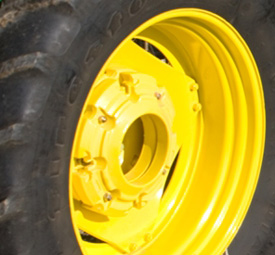 Rear-wheel weight
Rear-wheel weight
Cast-iron wheel weights provide added ballast at the tires for increased traction and stability.
For operators requiring additional ballast or additional traction on the rear axle
72-kg (159-lb), 205-kg (452-lb), 625-kg (1378-lb), and 970-kg (2138-lb) cast rear-wheel weights are available for the 7R and 8R Series Tractors. The attaching hardware for all rear-wheel weight options may be ordered through parts.
The range of rear-wheel weights can provide the proper amount of rear axle ballast for a variety of applications. The addition of this ballast will increase traction on the rear axle of the tractor. These weights can also be used to counterbalance the effect of adding additional weight on the front axle in the form of a front weight support, front hitch, front spray tanks, and front-end loaders.
72-kg (159-lb) starter weight
The 72-kg (159-lb) cast rear-wheel weight is offered individually as attachment R167153. This weight can be used either as an inner or outer rear-wheel weight. The 72-kg (159-lb) weight can be used by itself or as a starter weight for the 205-kg (452-lb) rear-wheel weights.
205-kg (452-lb) weight
The 205-kg (452-lb) cast rear-wheel weight is offered individually as attachment R07782. The 72-kg (159-lb) starter weight (R167153) must be installed prior to the 205-kg (452-lb) weight on rear steel wheels. This practice is optional on cast wheels; however, most weight packages will be configured this way.
625-kg (1378-lb) weight
R167151 includes one 625-kg (1378-lb) cast inner rear-wheel weight. This weight is to be used on the inside of the rear wheel assembly. This option can be stacked on a double-flat cast hub, with a 70-kg (154-lb) starter ring on the outside.
70-kg (154-lb) weight
BRE10026 features a 70-kg (154-lb) starter weight. The starter weight and guide lugs provide improved installation and removal of the 900-kg (1984-lb) weight. This weight can be used individually on the outside of the steel, dual rims on rack-and-pinion axles, or on the outside of the double-flat, single-taper wheel hub. For the approved cast hubs, can also be used with the inner cast weights as well.
NOTE: Use on the outer side of approved cast hubs will limit dual tire and spacing capability.
900-kg (1984-lb) weight
Individual R341378 900-kg (1984-lb) weights ordered through Parts. The 70-kg (154-lb) starter weight is required for installation, and provides guide lugs for improved installation and removal of the 900-kg (1984-lb) weight. 900-kg (1984-lb) weight ballast option is compatible with steel, dual wheels with rim diameters of 106.7, 116.8 cm, or 127 cm (42 in., 46 in., 50 in., or 54 in.). This allows the weights to be added to only the outer rear dual on a rack-and-pinion axle and double-flat axle with single-taper hub.
NOTE: This weight option is not compatible with 96.5-cm or 137.2-cm (38-in. or 54-in.) wheels.
 Rear-wheel weight
Rear-wheel weight
Cast-iron wheel weights provide added ballast at the tires for increased traction and stability.
Wheel Equipment
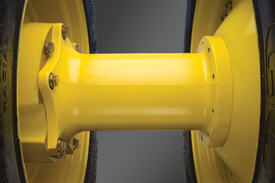
Front dual wheel extensions allows the ability to run front dual wheels (four tires on the front axle) at fixed spacing ideal for row crop applications using the 1500 or Independent-Link Suspension (ILS™) front axle (group 47-49 tires). Never install front duals on a 1300 mechanical front-wheel drive (MFWD) axle.
When either of these kits are installed, the front wheel base (outer to outer wheel) grows to 289.6 cm (114 in.), leaving both the front right and left wheel sets on 76.2-cm (30-in.) centers.
Refer to the operator’s manual: Front wheels, tires, and treads section and reference the stories on installing dual hub extensions. Installation instructions from the online library may also be used for reference.

Front dual wheel extensions allows the ability to run front dual wheels (four tires on the front axle) at fixed spacing ideal for row crop applications using the 1500 or Independent-Link Suspension (ILS™) front axle (group 47-49 tires). Never install front duals on a 1300 mechanical front-wheel drive (MFWD) axle.
When either of these kits are installed, the front wheel base (outer to outer wheel) grows to 289.6 cm (114 in.), leaving both the front right and left wheel sets on 76.2-cm (30-in.) centers.
Refer to the operator’s manual: Front wheels, tires, and treads section and reference the stories on installing dual hub extensions. Installation instructions from the online library may also be used for reference.
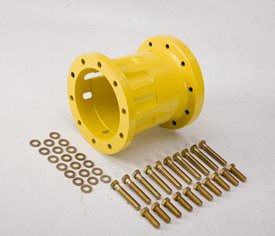 Hub extension kit
Hub extension kit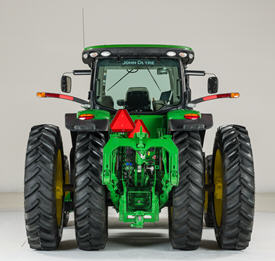 8R Series Tractor with dual hubs
8R Series Tractor with dual hubsHub extensions mount to the dual/triple hub to extend the steel wheel tread width for exact dual/triple-wheel spacing for 20-in. through 40-in. rows.
 Hub extension kit
Hub extension kit 8R Series Tractor with dual hubs
8R Series Tractor with dual hubsHub extensions mount to the dual/triple hub to extend the steel wheel tread width for exact dual/triple-wheel spacing for 20-in. through 40-in. rows.
 Hub extension kit
Hub extension kit 8R Series Tractor with dual hubs
8R Series Tractor with dual hubsHub extensions mount to the dual/triple hub to extend the steel wheel tread width for exact dual/triple-wheel spacing for 20-in. through 40-in. rows.
 Hub extension kit
Hub extension kit 8R Series Tractor with dual hubs
8R Series Tractor with dual hubsHub extensions mount to the dual/triple hub to extend the steel wheel tread width for exact dual/triple-wheel spacing for 20-in. through 40-in. rows.
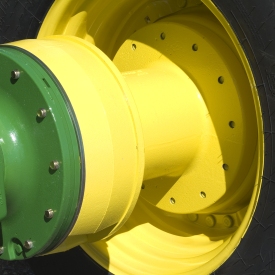 Front wheel spacer
Front wheel spacer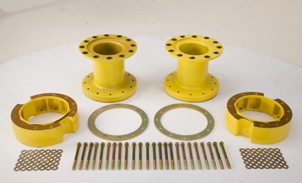 3-m (118-in.) front-wheel spacer kit
3-m (118-in.) front-wheel spacer kit3-m (118-in.) front-wheel spacing kits are available for John Deere 7R and 8R Series Tractors in order to reach 3-m (118-in.) row spacing.
NOTE: No longer compatible with 7R and 8R Series Tractors with Active Command Steering (ACS).
See below for tractor applications and limitations.
Large-frame 7020/7030/7R Series Tractor restrictions
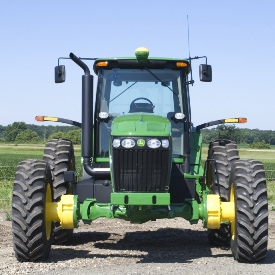 7030 Series Tractor
7030 Series Tractor
- 1150 or 1300 front axle with 12-bolt hub – mechanical front-wheel drive (MFWD) with or without Triple-Link Suspension (TLS™) tractor suspension
- No frame ballast (cast ballast can be used on rear axle and liquid in front tires)
- No front hitches, loaders, implements, or spray tanks of any kind allowed
- Not compatible with front brakes
- Extended wheel position will reduce turn angle on 7R Tractors
- Tractor ballast and speed of operation must not exceed tire manufacturer's recommendations for front tire load and speed
8020/8030/8R Series Tractor restrictions
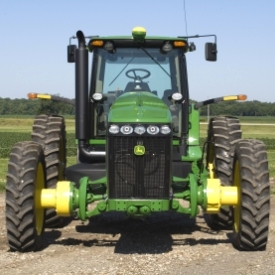 8030 Series Tractor
8030 Series Tractor
- Independent-Link Suspension (ILS™) vehicle suspension or 1500 Series axle
- Single front tires only
- 3-m (118-mm) rear axle
- No front hitches, loaders, implements, or spray tanks of any kind allowed
- Tractor ballast and speed of operation must not exceed tire manufacturer's recommendations for front tire load and speed
Prior to 8R late model year 2014 (serial numbers below 90000), all 8 Series and 8R Series Tractors utilized the same 3-m (118-in.) front-wheel spacer: RE267658.
For late model year 2014 and newer (serial numbers above 90000), there are two distinct attachments for attaining 3-m (118-in.) spacing: RE267658 and BRE10130.
- Attachment required for tractors equipped with a 1500 front axle: RE267658
- Attachment required for tractors equipped with an ILS front axle:
8245R | 8270R | 8295R | 8320R | 8345R | 8370R | 8400R | |
Model year 2014 (90000) | RE267658* | BRE10130* | |||||
Model year 2015 (100000) | RE267658* | BRE10130* | |||||
NOTE: No longer compatible with 7R and 8R Series Tractors with ACS.
 Front wheel spacer
Front wheel spacer 3-m (118-in.) front-wheel spacer kit
3-m (118-in.) front-wheel spacer kit3-m (118-in.) front-wheel spacing kits are available for John Deere 7R and 8R Series Tractors in order to reach 3-m (118-in.) row spacing.
NOTE: No longer compatible with 7R and 8R Series Tractors with Active Command Steering (ACS).
See below for tractor applications and limitations.
Large-frame 7020/7030/7R Series Tractor restrictions
 7030 Series Tractor
7030 Series Tractor
- 1150 or 1300 front axle with 12-bolt hub – mechanical front-wheel drive (MFWD) with or without Triple-Link Suspension (TLS™) tractor suspension
- No frame ballast (cast ballast can be used on rear axle and liquid in front tires)
- No front hitches, loaders, implements, or spray tanks of any kind allowed
- Not compatible with front brakes
- Extended wheel position will reduce turn angle on 7R Tractors
- Tractor ballast and speed of operation must not exceed tire manufacturer's recommendations for front tire load and speed
8020/8030/8R Series Tractor restrictions
 8030 Series Tractor
8030 Series Tractor
- Independent-Link Suspension (ILS™) vehicle suspension or 1500 Series axle
- Single front tires only
- 3-m (118-mm) rear axle
- No front hitches, loaders, implements, or spray tanks of any kind allowed
- Tractor ballast and speed of operation must not exceed tire manufacturer's recommendations for front tire load and speed
Prior to 8R late model year 2014 (serial numbers below 90000), all 8 Series and 8R Series Tractors utilized the same 3-m (118-in.) front-wheel spacer: RE267658.
For late model year 2014 and newer (serial numbers above 90000), there are two distinct attachments for attaining 3-m (118-in.) spacing: RE267658 and BRE10130.
- Attachment required for tractors equipped with a 1500 front axle: RE267658
- Attachment required for tractors equipped with an ILS front axle:
8245R | 8270R | 8295R | 8320R | 8345R | 8370R | 8400R | |
Model year 2014 (90000) | RE267658* | BRE10130* | |||||
Model year 2015 (100000) | RE267658* | BRE10130* | |||||
NOTE: No longer compatible with 7R and 8R Series Tractors with ACS.


















